If you would like a printed copy of any of our back issues, then they can be purchased on Farm Marketplace. You can also download the PDFs or read online from links below.
-
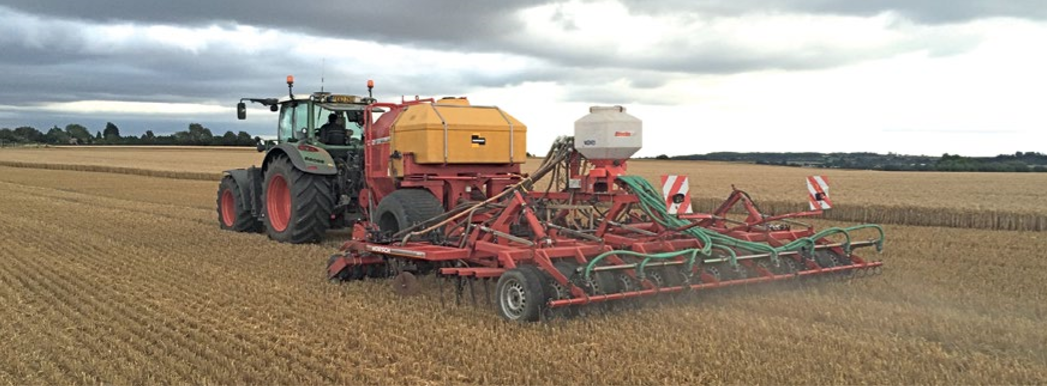
How To Start Drilling For £8K
Clive Bailye’s seed drill of choice is his 6m John Deere 750A , which has been used exclusively for 3-4 seasons. Last year, with an increased acreage, the founder and publisher of this Direct Driller magazine thought a second seed drill was necessary. Having just the one machine was a risk and in a difficult season would mean drilling was delayed. He looked around and found a good condition Horsch CO6 tine drill advertised in Germany.
Words and pictures by Mike Donovan
After delivery he rebuilt the coulters to a narrow profile so as to reduce soil disturbance. He says the tine drill is very useful driling after straw crops such as osr and also through the straw on second crop cereals.
Buying the drill from a German farmer was not particularly complicated, and provided him with a higher spec machine than Horsh sell in the UK. The seed dart tyres are much wider, and the machine is fitted with blockage monitors as well as full width front packers and also a liquid fert application system.
A sheaf of photos were taken, and Clive then asked for some of specific parts to show wear. The deal was done at under £5,000 which Clive says is the market value of these machines which are too large for small farmers to buy. Original owners like to buy new and sell when the machine is still in good condition.
Narrow tines with wear tiles
@Clive knew he wanted to make changes, substituting the Horsch tines and coulters for something far narrower, and has ended up getting his own design of tine made, which has a wear tile made from Ferobide, far harder than tungsten. The drill is on the farm primarily for osr and 2nd crop cereals drilled into chopped straw and the 25cm spacing is okay for these crops.
Comments on Clive’s on-line forum, TFF, said the drill many not be so good with beans, as the slot is a mere 12mm wide. And in barley the spacing may well be too wide as it needs to be thick. Clive points out that the seed pipe can actually be a bit wider than 12mm as it is in the shadow of the point. It would be good to have the option of using it for beans.

Above left: The cheap CO6 is being calibrated ready for its first outing

Above right: The adapted Horsch is being filled by the home built drill logistics trailer with seed and liquid starter fert.
Getting around the German instructions
The Horsch came, of course, with a control box and instructions in German. More on-line discussion revealed that English instructions were available on the Horsch website, and another explained that Horsch was sourcing some of these parts from Agton in Canada anyway. Zealman from New Zealand explained that the button marked with callipers should be held down for around 5 seconds. The menu is where you adjust the tramline sequence, valve layout and row numbers.
Ball hitch is a continental standard and provides a positive connection between tractor and drill

The Stocks Wizard has a rotor modified for Avadex which otherwise leaks everywhere
A Stocks Wizard is on the back of the drill and used for Avadex. Here again the knowledge of actual farmers is helpful. Alistair Nelson warned that the rotor and the surrounding shroud need to be changed, and he got good advice “from Rick at Stocks”. Clive has the same setup on the 750A and says that the Avadex leaks everywhere unless the modification is made. The drill was acquired and modified in 2016 and the results have been excellent.
The machine went through the residue without many problems and having the second drill has meant more timely planting. Clive has shown that moving into No-Till is not the expensive exercise so many farmers think it might be. The total cost, after modifications which included replacing all tines and coulters, was under £8,000.
Author Mike Donovan writes: we have featured a number of home made direct drills in @Practical Farm Ideas, and are always interested in seeing more. Please contact mike editor@farmideas.co.uk or 07778877514.
-
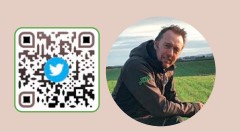
Farmer Focus – Neil White
Berwickshire farmer Neil White calls for clarity and equity in their baseline carbon audit on his farm after six years of
No-till
Harvest 2021 was, in the end, better than expected. The crops came out of the wet cold spring looking respectable, but then continually improved to culminate in some top yields and good quality grain – not the case across the country, but in SE Scotland we had our turn at an easier and drier harvest this year.
I still run two systems to establish my barley crops, still ploughing a small percentage mostly due to remedial drainage work or the risk of wheat volunteers. I sowed the winter and spring barley crops with the Mzuri and comparisons with the plough/powerharrow combination drill were very interesting again this year. The Pearl winter barley sown with the Mzuri went into winter looking the better crop but in the wetter spring it stalled, and the conventional sown crop overtook it, maybe accessing available nitrogen quicker. The carrying capacity was noticeably different, the Mzuri ground carried the sprayer and spreader 6 or 7 days earlier without marks. This year the winter barley yield was admittedly better on the conventional by around 0.4t/Ha but still all above my historical average.

When I worked out the margin there was very little in it with the Mzuri sown crop just coming out on top. The biggest surprise was in the Diablo spring barley where the yield was reversed and the direct drilled came out on top despite it looking thinner. The higher yield and lower cost of establishment is always reassuring as I move towards 100% direct drilling. I have in the past noticed a bolder grain in the wider row, direct sown barley, maybe due to extra light inception on the upper leaves. But this year it was all very similar and all in spec for malting. This year I have the same two methods and conditions were perfect. I felt I still needed an earlier start in the direct drilled crop, so I went around 10 days earlier with the direct drill to aid establishment, so far everything looks great.

Like all winter crops in this area my cover crop went into perfect conditions, I don’t think Berwickshire has ever looked better going into December. Sown on Sep 3 the mixture of home saved spring beans, phacelia and buckwheat made up my relatively cheap cover crop. It was sown in one pass at two depths, beans at 2.5 inches down the front leg and at the coulter the phacelia and buckwheat 1 inch. It was sown at a faster than usual sowing speed, all at 12kph no spray or rolling and as the picture shows it has exceeded my expectations above ground. The first frost has killed off the buckwheat and I am hoping some hard frosts over new year may kill the beans leaving an open cover with only the phacelia to spray off ahead of hen muck and spring oats for Quaker. The concern I have about a strong cover over winter is if the ground fails to dry in the spring it may leave a wet seed bed prone to smearing, ideally 2/3 of this cover should be dying back or dead by New Year.

The companion cropping in the oilseed rape, while maybe doing unseen things, didn’t help gain yield or supress the pigeons, so I didn’t do it this year. It was inconvenient at sowing time and in the case of the clover, had very poor establishment. This year’s rape crops have covered the ground well, they are looking strong and go into winter looking well. I hope this will suppress the pigeons (for now). Slugs and pigeons are the main risk for rape here and while I vary my cereal seed rate, I would also like to move to variable rate on my slug pelleter. I have already mapped the heavier parts of my fields for the variable seed map, so I could also put a slightly higher rate of pellets on heavy areas while reducing rates on the lighter ground. This would give more targeted coverage without using more product. This is something to unlock or explore ready for next year’s rape.
I was asked to talk at a couple of events recently, the bigger one being the NFU’S autumn conference. I shared the real stage with ‘virtual’ Prof Jude Capper. Prof Capper had some excellent stats and made some fantastic points regarding sustainable British livestock production, worth looking up. The topic was Sustainable Farming, a very broad remit but I do firmly believe what I have done over the last 6 years has made my farm more resilient and sustainable in every way, it is now better placed to face the challenges ahead. There is an enormous desire for information and discussion around reduced tillage and direct drilling and magazines like this will play a part in that process. There is however still a fear in Scotland that we will be forced down this road by government and that will be a difficult route for many who haven’t considered trying it yet.
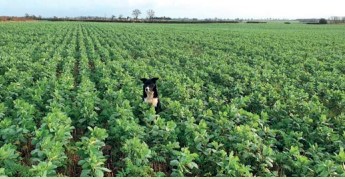
After an invite I sent the day she got the job, my son and I had an on-farm visit from Mairi Gougeon, Scotlands cabinet secretary for rural affairs and Islands. It’s always good to have politicians on the farm as they often openly admit there are gaps in their knowledge of modern farming practices. I think the political threat is one of the hardest to protect against or predict. We are still waiting for the Scottish governments new BPS which will take us from this limbo period into what looks like a ‘greener’, targeted, apply and fund, scheme led system. I conveyed my concerns regarding the combinable crop sector being overlooked when these schemes are devised and how nothing I have done in reducing tillage, companion and cover crops or machinery purchases tick a box or allow access to funding this side of the border. The main point I tried to address however is Scotland are going to have a baseline audit that gives a figure for your carbon footprint, eventually this will include biodiversity. I don’t have a problem with that as such, but every company I know which makes these calculations comes up with a very different number.
So, do I get the worst figure the first year and then save the favourable one until later, showing a good improvement or start with the best and hope I’m already ahead of the game? Who knows? We suggested that NFUS should have investigated this years ago when we asked them to and the company whom WE choose carried out the work. We are about to give away a huge amount of data and could be setting ourselves up for a tough time from environmentalists. If governments agreed an internationally recognised process to calculate these figures, then I’m sure it could help us sell our produce at home and all around the world. We must start with a level playing field that shows consumers what the actual consequences of their purchase are, good or bad! British agriculture should be shouting about the quality of our production methods and standards and not let others convince us we are the major polluters or destroyers of habitat, that is not British farming.
-
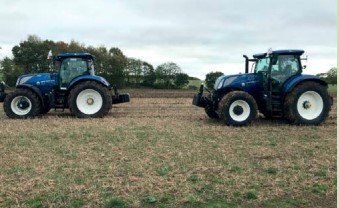
Michelin Tracks & Tyres European Tour
Written by Mark Hatton
I was recently, lucky enough, to be invited to attend the UK leg of the Michelin Tracks and Tyres European Tour in Cambridgeshire. The event was to showcase the features and benefits of their VF AXIOBIB 2 tyres, the latest track technology and the benefits of using the PTG Central Tyre inflation systems to vary tyre pressures to improve efficiencies, which we will focus on in this article, it turns out there’s much more to tyres than just being black and round!
With tractors supplied by New Holland, a pair of identical T7.270, one fitted with Michelin’s Very high Flexion VF 710/60 R42 and VF 600/60 R30 Axiobib 2 tyres and the PTG Central Tyre inflation system, the other tractor fitted with 650/65 R42 and 540/65 R30 Multibib tyres. The event began with a demonstration to highlight the difference in tractive effort between different tyre pressures. To create the load a New Holland T8 SmartTrax was deployed to create resistance: lets call it the brake tractor method. This keeps the tractor at a constant speed, as it accelerates the wheels increase the tractive effort.
This is the most reliable method for comparing traction efficiency, in the form of weight and resistance. This is done to measure the tractive effort at the drawbar. A sensor integrated into the drawbar linking the tractor to the convoy will measure this effort, which is a value in decanewtons (or kg). Linked to this sensor, a live display screen, allow us to see this value. The higher the value, the higher the tractive effort. In other words, the higher the tractor’s traction. Two runs were made with the T7.270, fitted with, Michelin’s Very high Flexion VF 710/60 R42 and VF 600/60 R30 Axiobib 2 tyres at different pressures, altered via the PTG Central Tyre inflation system. At a constant speed of 4.6 km/h, we can see an average of 6800 decanewtons or kg

The higher the value, the higher the tractive effort. In other words, the higher the tractor’s traction. By reducing the tyre pressures from 16 Psi to 10 Psi, we saw an increase of 17% tractive effort from of 6800 decanewtons to 8000 daN. This increase provides benefits in the way of reduced wheel slippage, less soil structure damage, increased fuel efficiency and overall improved machine productivity. The second test was a demonstration comparing tyre sizes, type of type (ULTRAFLEX and MULTIBIB) and tyre pressures. To achieve this, the New Holland T8.SmartTrax was again deployed to act as the resistance, by connecting both of the T7.270’s with a cable, which passes through a pulley attached to the T8.Smarttracx , Like for the previous tests, the tractors are set to travel at an identical speed. We will see over a given distance how many meters are gained with the more efficient configuration. The tyres pressure were again set on both machines, for the AXIOBIB 2 with CTIS is set as the previous test: rear 0.7b (10 Psi) and 0.6 b (9Psi)
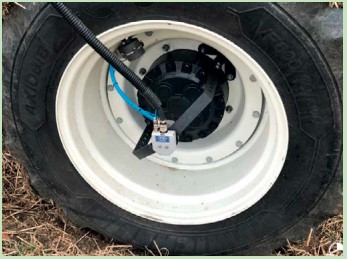
The tractor fitted with the Multibib, a pressure of 23 Psi, was selected as the most used pressure by farmers in UK. As the tractors set off down the field, it was easy to see the difference between the two. The T7.270 fitted with the VF AXIOBIB tyres, set at a lower pressure quickly pulled ahead of the tractor fitted with the Multibib tyre. As with the previous test, the benefits of the different tyre technology between the AXIOBIB ULTRAFLEX and the Multibib, in combination with the lower tyre pressures, resulted in better traction and increased productivity.
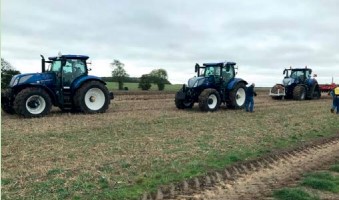
The impact of reduced tyre pressures on soil structure can be seen easily with the following experiments. The soil footprint sandboxes show the difference in tyre type and pressures, as shown in the table below:
• A: MULTIBIB 650/60 R42 MULTIBIB – Most used pressure by farmers in UK: 1,6b (23 PSI)
• B: VF710/60 R42 AXIOBIB 2 & CTIS PTG – ROAD PRESSURE → 1.1 bar (16 Psi)
• C: VF710/60 R42 AXIOBIB 2 & CTIS PTG FIELD PRESSURE → 0.7b (10 Psi)

The bigger the footprint, thanks to the reduced pressure, the higher the traction. In term of soil protection, bigger footprint reduced the kg by cm2 and spread the load on more surface. This ties in with the final test which calculates the weight transfer through the soil structure, compaction. By using probes inserted horizontally into the soil at around 20cm, When the vehicles go over the sensor, the probe is compressed, and the compression is measured every time a vehicle goes over the top. Even at tyre pressures of 23psi, there is less than 1 bar of pressure at 20cm depth (tested with the T7.270 on the MULTIBIB 650/60 R42
Around 10 years ago, Harper Adams University conducted a study on the effect of pressure on yield. This study, which was carried out using a wheat crop, involved growing plots side-by-side.
The same soil composition, the same seeds, the same crop protection products, the same tools, vehicles, crop growing techniques. Only one factor was different: for one plot, the vehicles were fitted with UltraFlex tyres (so low pressure), and in the other, standard technology tyres (higher pressure), like today. And this was throughout the growing cycle. As we offer ULTRAFLEX VF tyres for all farming vehicles: tractors: small, medium and high power, harvesters, sprayers, self-propelled spreaders, dump trucks and trailers, etc.
After harvesting, the university recorded an average 4% improvement in yield.
• 1 – Every year is different: the weather in particular, or the effect of previous crops, the choice of seeds, vehicles, etc.
• 2 – We need to have a complete vehicle fleet management approach. As we need to optimize tyres all year round for each task in the field and for all vehicles. It is not logical to have a tractor at 0.9 bar with tyre trailer at 4 bar.
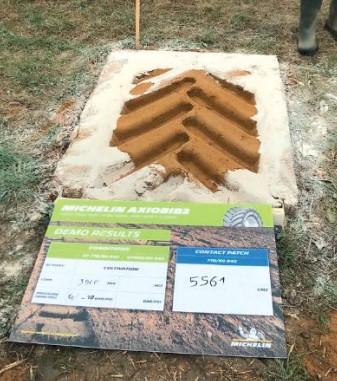
The more the soil is protected, the more productive it is. The 4% average, also reported in US and Brazilian studies on soy and maize crops, represents a real return on investment.
Overall, Tyre choice and tyre pressures can directly affect not only soil structure and health, but play a huge part in increased productivity, machine efficiencies, primarily by increased traction, allowing larger implements to be operated and less wheel slippage damaging soil structure, overall not only better for the soil but better for your business as well.
-
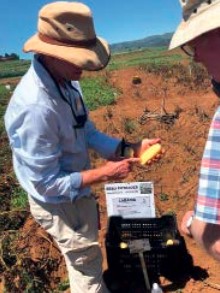
A Sustainable South African Story
Justin Platt says “I was very fortunate to grow up on a farm in the beautiful Midlands of KwaZulu-Natal, South Africa. With no real agricultural experience to speak of, my father left the family printing business in the late 1950s and established us on 500 acres of farmland, a small fry by modern commercial standards but more than enough to build a diversified ‘mixed’ farming operation which included a diverse rotation of cash crops, pasture, sheep, beef and dairy cattle, and a small farm dairy. The KZN Midlands are blessed with excellent soils by Southern African standards, being predominantly dark and well-structured with a low PH, approximately 4% organic matter and high aluminium levels, that required the necessary calcium related remediation. My upbringing on these soils and in this environment laid the foundation for my later focus on improving soil health and regenerative agricultural practices as the keys to farm profitability and sustainability – although I didn’t quite know it at the time!”
After leaving university with a degree in botany and plant pathology, I spent my first five working years in the world of industrial agriculture corporations, where I was involved in testing and marketing new coded fungicides, herbicides and insecticides for well-known multinational chemical companies. The large skull and crossbones on each container were disturbing and the experience convinced me that there must be a better path. Unfortunately, my views were not shared by many at the time.
Conventional South African agriculture in the early 1990s, like most agricultural industries around the world, was firmly settled onto the treadmill of excessively high inorganic fertiliser applications coupled with a scary cocktail of chemical pesticides, fungicides and herbicides. We could see the harm this approach was causing to our soils, ecosystems and especially farm viability, so with the encouragement and backing of a small group of progressive and innovative growers, we set out to explore opportunities to develop alternative products and solutions with a focus on improved soil health as the foundation for successful and sustainable crop production.
A key turning point in our journey was a 2004 visit by Graeme Sait, a prominent advocate of ‘nutrition farming’ from Australia, who delivered a four-day conference on regenerative and nutrition farming to our audience of growers, researchers and industry members. The response was phenomenal! While this conference and subsequent editions that we ran over the next fifteen years played a crucial role in driving interest for these alternative methods and products we were advocating, our immediate challenge was addressing the lack of infrastructure, expertise and readily available local raw materials required to meet the demand here in South Africa.

Taking off from there, our ongoing focus over the past decade and a half has been on building the capacity and structures required to support the groundswell of growers both in South Africa and around the world who are making the transition to regenerative agriculture. Based on the demand created by a paradigm shift towards regenerating tired and damaged soils, we launched into relatively uncharted waters to develop organic raw materials locally, that would serve to manufacture “soil food’’ products. South Africa is blessed with abundant raw materials all of which require refining and value adding to create purpose-specific products. In many cases, the raw materials we source are natural waste and effluent byproducts from other industries (sugar processing and fish processing to name two), which work beautifully as microbe food. A win for all parties.
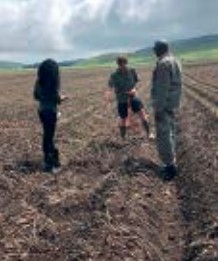
Whilst our range of raw materials and registered products form an integral part of a regenerative management program, there are no silver bullets. These, together with the balanced use of microbial products, cover crops, minimum tillage, an animal factor, and a good dose of common sense will contribute to farming profitably and restoring our natural environments in essentially any farming context around the world.
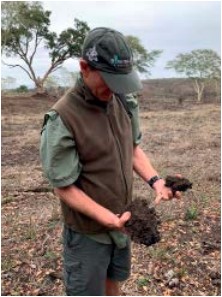
In the end, the success of any grower will be decided by their determination to make the transition! As Henry Ford said, “Whether you think you can, or you think you can’t – you’re right.”
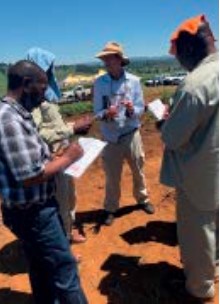
A fundamental pillar of the Regenerative Agriculture community over the past few decades has been knowledge sharing and the free flow of support and ideas. After several years of effort in building our capacity and product range here in South Africa, coupled with a supremely favourable exchange rate, we are excited about the new opportunities presented to us by other agricultural regions, especially the UK. We welcome any advice and input as we undertake this challenge! We also plan to attend Groundswell in June 2022, where we hope to meet as many of you as possible.
About the Author:
Justin Platt founded Zylem in 1990 and is the Managing Director of the business to this day. Based in KwaZulu-Natal, South Africa, Zylem is family-owned and operated. Justin’s wife (since 2005) and two sons (since 2021) have joined him in the running of the business. For more information or to get in touch, please see the details below:
W: www.zylemsa.co.za
E: justinp@zylemsa.co.za
L: www.linkedin.com/company/zylem-sa
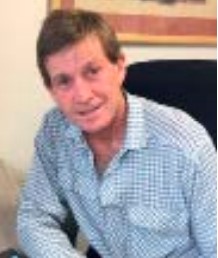
-

Drill Manufacturers In Focus…
CHALLENGING AUTUMN WEATHER UNDERLINES THE NEED TO TAILOR CROP ESTABLISHMENT
APPROACH TO PREVAILING CONDITIONS
Despite a stop-start harvest and the very changeable weather which followed, Suffolk farmer Jeff Claydon was able to establish all the planned area of winter crops. But, he says, this autumn highlighted the necessity of having a flexible approach and the ability to utilise windows in the weather.

24 November 2021
Harvest was a stop-start affair this year. After a marathon run with the combine early on, we were ahead of schedule until 15 August, but then had eight days with measurable rain. They say that every cloud has a silver lining and the interruption to harvesting allowed us to immediately start drilling DK Excited oilseed rape at just 2.7kg/ha directly into chopped straw and stubble with our new Claydon Evolution drill (to be launched at LAMMA 2022). We drilled all our oilseed rape in excellent conditions on 16 / 17 August, the first cotyledons appeared five days later and 4kg/ha of Ironmax® Pro (De Sangosse) slug pellets went on to sort out any slugs that were present because of the moist conditions.
The damp weather and slightly cooler temperatures resulted in excellent establishment and fortunately the dreaded cabbage stem flea beetle did not appear. Centurion® Max was applied to control annual grass weeds and we have been pleased with how the oilseed rape has grown away. As I write this the soil temperature is still 10.5°C, well above average for the time of year, and with the crop growing strongly conditions are too warm for the Kerb® to go on.
Conditions were not dry enough to fire up the combine again and begin harvesting the remaining area until the first week of September. In the interim, the prolonged spell of wet weather caused our spring oats to go flat so we were unable to accurately assess yields and draw firm conclusions from the various cover crop treatment plots on that area. However, a visual assessment suggested only minor differences between them.
Moist soil conditions provided ideal conditions for slugs, which will undoubtedly have been a problem on some farms this season, underlining the importance of a robust approach to stubble management. Dealing with slugs and slug eggs effectively is key to success, especially where winter wheat follows oilseed rape, so after harvest I regularly check fields when the soil is damp. Clearing away crop residues that have remained undisturbed for days will reveal slugs and slug eggs, allowing appropriate measures to be taken. In the early days of developing Claydon Opti-Till® we sometimes had problems with slugs where stubble management was not used, so it has been a cornerstone of post-harvest operations on the Claydon farm ever since. We do not want to rely on slug pellets, so the aim is to take out as many slugs and slug eggs as possible using cultural and mechanical methods, such as the Straw Harrow.
The late finish to harvest meant that we had only four weeks before starting to drill winter cereals, so a cover crop would not have had time to develop fully or justified the cost. We could have used this technique on land destined for spring oats but the glyphosate which went on at the end of October made such an excellent job of killing weeds and volunteers that there was little point. The more resilient seeds which germinate over the winter will be taken out with a second application of glyphosate before drilling the spring oats.
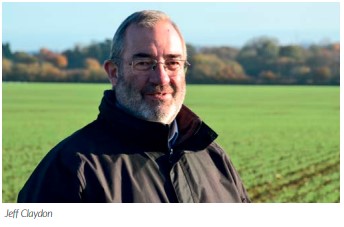
The performance of the winter wheat which followed oilseed rape confirms that our approach to stubble management works well: even the headlands are perfect! Everything was drilled by mid-October, helped by the fact that Claydon Opti-Till® enables us to establish crops in 20% of the time, at a fraction of the cost and using 10% of the fuel, less than 15 l/ha, than would be required with a conventional plough-based system. Such high productivity counts for a lot when the weather is catchy, the window of opportunity is limited, and the number of drilling days are far fewer than in a more protracted season.
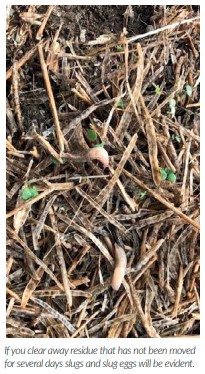
This autumn was unusual and with rarely more than three or four consecutive dry days the soil was always moist. In October, for example, we had 48mm of rain in just two days. Although that was a great benefit in helping the preand post-emergence chemicals do their job, the moist soil stuck to the tractor’s tyres, and it was virtually impossible to Cambridge roll after drilling as we normally would. Instead, we ran our Claydon Straw Harrow at a diagonal to the direction of drilling and found that it did a much better job than rolling under poor conditions, which would have squeezed the air out of our heavy clay soils and created wheel marks in the crop. The Straw Harrow has delivered exceptional results and the crop has established better in the high-humidity seedbed than if it had been rolled.
Crops are looking good
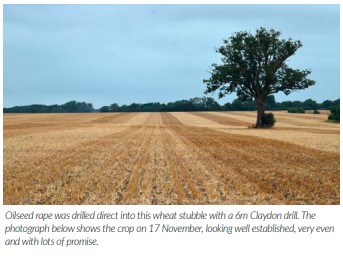
I am pleased to report that we now have some exceptional crops, which were established on time, according to plan and with very few issues, despite the challenging weather. The variable conditions underlined the importance of responding to what nature throws at us and adapting the crop establishment techniques accordingly, rather than sticking rigidly to a set formula. Having developed Claydon Opti-Till® we know every nuance of how it should be used, but existing Claydon users or prospective owners who require any guidance should contact our team who will be pleased to offer advice.
Earlier, I mentioned headland establishment. The performance of these often-overlooked areas is fundamental to achieving high average yields because even on a relatively large arable farm they can easily account for 25%-30% of the total field area. It is easy to become complacent when the display on the combine’s yield meter shows 10t/ha-plus in the middle of the field, but rarely does that reflect the true field average.
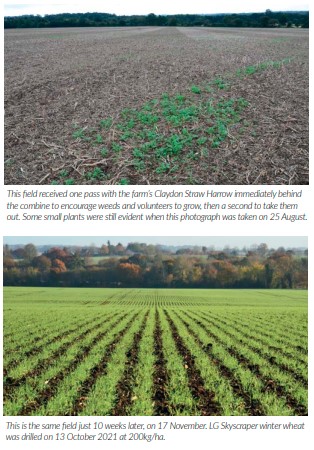
On the Claydon farm the 2020 harvest underlined the importance of getting the headlands right, in terms of ensuring adequate drainage and eliminating wet spots, minimising compaction, ensuring good crop establishment, and reducing pest damage around field boundaries. For some, or all, of those reasons, in 2020 some of our headlands underperformed the main field areas by 30%- 40%, which had a significant detrimental impact on average yields. Even in that difficult season we still averaged 9t/ha of winter wheat, but what could it have been if all those areas had performed to their full potential? Having remedied any faults, we hope to have an answer to that question next harvest.
The combination of warmth and moisture in the weeks following harvest meant that the worm population went into overdrive, taking down almost all crop residues in a matter of weeks, helping to unlock valuable nutrients for the growing crops which will hopefully help to keep input costs under control given where nitrogen prices are currently.
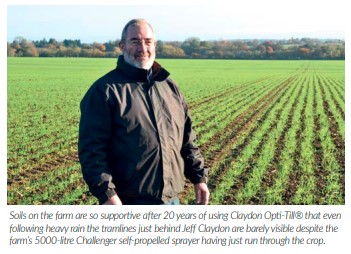
Because of conditions this autumn some farms struggled to get crops in the ground, and they have been slower to develop. The spring will bring the dilemma of how much nitrogen to apply and whether to cut back on other inputs, because there is no point in throwing money at a crop with limited potential. However, crops that have established well are worth nurturing and developing their full potential will pay off. It is too early to calculate exactly final average yields from the 2021 harvest as all our spring oats and most of the wheat is still in our grain store. However, indications are that the wheat averaged 9t/ha and is selling for £170 – £250/t generating excellent returns, while the spring oats did 7t/ha. The oilseed rape came in at 3.3t/ha and all of it has left the farm at £500-£600/t.
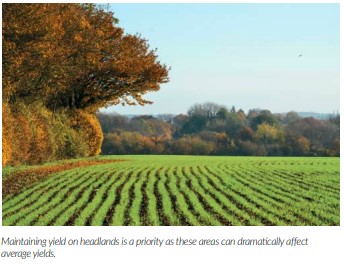
My accountant has just informed me that the farming operation has made a profit again this year, even before taking support payments into account, so that is exceptionally good news. Higher prices for what we produce will partly offset much higher input prices, but it will be important to keep a close eye on the balance between the cost of inputs and their potential benefits.

The wall-to-wall coverage of the COP26 event in Glasgow over the last couple of weeks underlined that the focus on reducing emissions will only increase and as farmers we must find ways of reducing our carbon footprint. In conjunction with Yara, Claydon have been studying the relative efficiency of establishing crops using Claydon OptiTill® against conventional techniques. Early indications are that the Claydon System retains around 30% more carbon in the soil, so we are off to a good start, but we will be investigating this in more detail in the coming year.
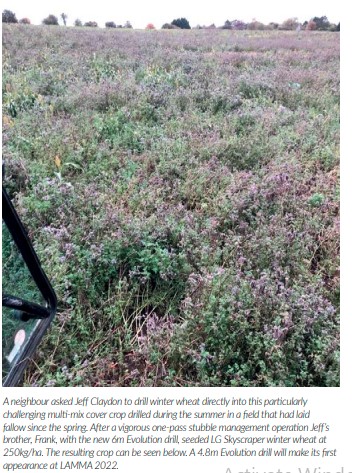
-

UK Carbon – Code Of Conduct
Written by Doug Wanstall from Re-generation Earth

We are in a climate emergency, it is down to everyone to make a difference and with that in mind a group of land managers, tech and finance experts have come together to ensure that farmers and land managers benefit from the burgeoning carbon market whilst ensuring a robust system of project approval, measure, reporting and verification (MRV) protocols is created.
The idea was borne in 2015 when one of the founders of the system, Doug Wanstall completed a Nuffield study looking at building financial resilience in farm businesses. It happened to coincide with the Paris Climate talks at which there was a lot of chatter about a project called ‘4 per mille’ A group of French scientists had calculated that if all the worlds’ soils increased their organic matter by 0.4% per year they could sequester all anthropological CO2. A massive undertaking but it was the lightbulb moment when Doug realised that land management and more importantly change in land management would play a significant role in the reversal of climate change and biodiversity collapse.
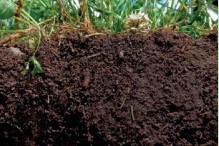
After an exhaustive 5 further years, gathering information, reading reports and putting together a dynamic group the UK Carbon Code of Conduct and its associated block chain enabled carbon tracking, registry and market place is ready to be launched in Q1 2022.
It was important to the group to ensure that the system was robust and capable of being scrutinised by investors, press and those that may wish to accuse carbon credits of being no more than a way that big companies can ‘greenwash’ their operations.
The code and associated immutable information system have been developed to ensure that the carbon credits issued from UKCCC approved projects are fully fungible, investment grade offsets, capable of assuring any customer of their validity. UKCCC approved projects have to uphold the 4 pillars of the code, Assured Permanence, Assured Additionality, Avoidance of Leakage and the Avoidance of negative outcomes. It is of vital importance when developing projects that issue carbon credits that the projects go through a thorough process of approval, otherwise a land manager may run the risk of having to pay back money paid for credits that turn out to be less than robust.
Sequestered carbon needs to be additional and occurred due to the change in practice that is being rewarded. Projects are long term, usually 25 years and reward a trend in actual, measured sequestration into soils, timber, biomass and biodiversity habitats. Tenants can partake in the process as long as they have a minimum 5-year term. They have to actively engage with their landlord who should give approval to enter a long term agreement. If a tenancy ends then soil tests are taken and the outgoing tenant will be issued the credits accrued to date. The same soil tests then become the baseline for the incoming tenant and the whole project is assigned. So far landlords seem to have been receptive to this approach.

Why write a new code? The answer Doug responds is simple. Globally there are a range of carbon codes with the Clean Development mechanism being amongst the originals and the Gold Standard and Verra following on as the main global leaders. Discussions with all 3 led the team to realise that none of them were going to work in the UK as they were simply too costly and complex, meaning much of the benefit of offset investments was lost in the cost of administering the scheme. In addition, the team, having spoken to a carbon exchange based in Geneva realised that they were buying Gold Standard credits from third world countries for less than $10 per tonne and selling them to their European clients for over $30 dollars per tonne, again delivering little or no benefit to the ones on the ground doing the work IE the land managers.
Back home in the UK there was the Woodland Carbon Code and Peatland carbon codes, both very sector specific. There is talk of a soil carbon code and groups developing grassland, hedgerow, wetland and salt marsh codes, the team decided a single code that could encompass all of these elements was most likely to work and be accepted by the majority of landowners. The UKCCC is a single set of standards that each project has to adhere to, then depending on the elements adopted by the project there are a range of MRV protocols to follow that measure, report and verify the outcomes of the project. This means that whole landholdings and even landscapes can become a single project and benefit from carbon sales. New woodland, wetland creation, a move to regenerative agriculture, carbon cropping, biochar production and use, agroforestry and biodiversity habitat creation can all be approved under a single project.
The aim is that the UKCCC is nimble and that it adapts to new and innovative ways to remove atmospheric greenhouse gases. The UKCCC will look at all nature-based solutions that can deliver additionality and permanence as long as a suitable MRV protocol have been developed. The code actively responds to the latest UK Climate Change Committee reports and other scientific and research papers, the aim to ensure best practice at all times and to respond to latest climate thinking. The code has a technical committee that works on the version cycle and in the early days new versions will be released as the consultation process continues.
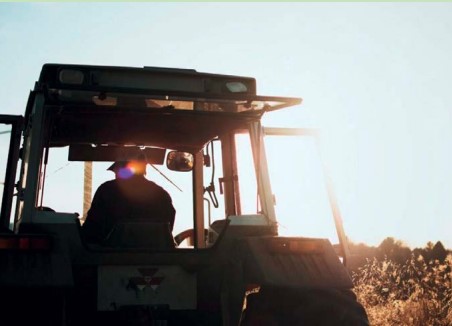
The approval process is simple but robust. The first stage is to appoint a UKCCC approved project developer with whom the project host will develop the project and help the host move through the approval process. The project developer will help identify the opportunities on any farm and will have an in-depth knowledge of regenerative agriculture as well as the UKCCC approval process. The next two steps are vital, firstly to establish the project hosts current net CO2 position and secondly establish the baseline.
No project host can sell carbon without first being carbon neutral. Currently the UKCCC does not insist on any particular carbon calculator use but this is likely to change as the UKCCC looks to build uniformity in the system. Either way, it’s important to be honest with the information that gets logged, the project developer will challenge many of the report findings. Baseline soil tests are one of the most important elements and should be taken as soon as possible, regardless of how, if or when a land manager might be planning to sell excess carbon. One of the main pillars of the UKCCC is additionality and nothing counts before a baseline has been taken. Historic tests can be used but a higher discount factor may be applied depending on the type of test and how many samples were taken.
Once these two elements have been established the project design process can begin. The project developer will walk the landholding with the host and discuss the options, the aim will always be to help maximise the opportunity. They will look at whether the host has a desire to move to more regenerative practices and help the host along that journey, look at how nutrient use can be optimised, where opportunities may exist to convert some land to biodiversity projects, if agroforestry is a desirable option or growing carbon crops that sequester large amounts of CO2.
Once the project detail has been discussed a project plan template is completed along with the associated documentation and an annual monitoring plan completed. Once all this is done the project is forwarded to the UKCCC for final approval or comment. The UKCCC undertakes to approve or make suggestions for amendments within 28 days. Once approved, credits are issued on an annual basis less a discount factor dependant on the risks associated with the project. The discounted credits are held on the registry but in a buffer until successful 5-year verification that measures the actual outcomes of the project. Exceed the planned outcome and more credits are issued, not meet the planned outcome and the required number of credits are deducted from those held in the buffer.
Every year the project developer conducts a light touch audit with the project host to ensure all is on track, update any best practice learnt in the interim and to complete the annual monitoring report. The UKCCC system may seem onerous but it is amongst a small number of carbon credit issuance schemes that will stand up to extreme scrutiny and ensure that neither the project host nor the customer for the credits can be accused of green washing. More often than not reducing carbon emissions makes good business sense in the first instance, the lower a landholdings carbon footprint the greater the opportunity to sell excess carbon.
The recent announcement of further detail of DEFRAs much vaunted Sustainable Farming Initiative contained no surprises and is actually a big help to those wishing to start the journey of regenerative agriculture. Those entering the scheme will have to test for soil organic matter, something that will help to establish the baseline required to enable carbon sales. A soil health management plan will form part of the UKCCC project design process and will help satisfy the requirements of the SFI.
The UKCCC is onboarding project developers now and these can be individuals, companies, land agents etc. Project developers need to have an in-depth knowledge of regenerative agriculture and have a keen interest in working with the code to continually improve the system. The aim of the UKCCC is that it becomes part of a wider eco system of people, land managers, businesses that all have the shared goals of reversing climate change and biodiversity collapse.
Expressions of interest are being taken now to join the scheme to enable project hosts to start the process in early 2022. In the first instance interested parties, both land managers acting as project hosts and potential project developers should send a short email to info@ ukcarboncode.org to register their interest.
-

Farmer Focus – Steve Lear

What a different a year makes…
Steven Lear fine tunes his arable cropping, and looks to
Aberdeen Angus to produce some low cost beefAfter the soul destroying previous two autumns when we managed to drill very little winter grain, this year has been rather refreshing. After cutting all of our spring crops in half decent conditions we have been able to establish all of our winter cropping with relative ease this year. I was planning to drill a little earlier this year and make a start in the last week of September, but a bit of moisture came through which delayed us into October. I’m very thankful for that as it has meant delayed drilling will have helped somewhat with blackgrass control. On some of the worst blackgrass fields control from pre-ems has suffered a little from the lack of rainfall through November, I’m hoping the next week or so we will have a little rain to get them to knock the grass weeds back before the cold really sets in.
Both the Crossslot and the Simtech drill have been out this autumn and, in a few cases, we have run them in the same field to get a comparison. The Simtech crops seem to get going a little faster which is probably due to some mineralised nitrogen from slightly more disturbance but also chits a little more blackgrass (this has probably been made worse due to not being able to roll some areas). It will be interesting to see any differences throughout the season and on the yield mapping at harvest time. We drilled a few fields of OSR this year which is a crop we have stayed away from for the past 7 seasons. We have seen a big difference between the hybrid varieties which seem to have got up and away and the conventional varieties which didn’t really get going and consequently ended up with a huge amount of flea beetle damage. The conventional was also drilled on heavier soil and I wonder if that has been a factor in their demise. I wasn’t prepared to use an insecticide on the osr so as a result I have redrilled 60 acres of brassica with some group1 milling wheat, given the prices at present it may not have been so bad after all.

On the wheat side we have drilled Zyatt, Extase and Nelson on the farm this year, all group 1’s. Extase is new to us, but first impressions is that its very fast out of the blocks. The Extase and Nelson are both being grown due to their fantastic disease profile, maybe going forward I’ll have a go at a group 1 blend if the markets I sell into will accept it. The Zyatt went in late and is probably a variety that we won’t grow on again as it’s become fairly susceptible to fungal disease. Soil conditions at drilling on the heavy clay have been some of the best we have ever seen. Zero till has certainly changed how our soil is behaving. What used to be a smeary mess now has crumb structure and it’s a real joy to see. We still however notice a big difference where we have mole ploughed so that is going to be something we do slightly more of compared to our old tillage regime. When direct drilling clay soils I believe good drainage is key, especially in the first few years.
The big question we have going into this season is how much fertilizer to use. With urea prices well over £700 last time I looked it is just the push we needed to bring nitrogen use down and develop techniques to drive efficiency of the nitrogen we do use. As our soils have historically had a large amount of manure, cover crops, legumes and composts we should be mineralising a fairly chunk of our nitrogen requirement through natural processes. With this in mind we have come up with a bit of a plan.
How we plan to increase nitrogen efficiency and use less
nitrogen.• Use a little and often approach. Smaller doses of N at more regular intervals will hopefully increase NUE.
• A lean towards more foliar applications. Foliar N has a much better NUE than soil applied so we need less of it. (It is however a lot more expensive).
• Back loading our N. We plan to delay applications of N to allow the natural soil nitrogen supply to provide for the crops earlier in the season. This may also reduce our need for fungicides as we won’t have large green biomass crops early on in the spring.
• Our poorer land which tends to need higher nitrogen applications has been allocated to spring beans this year.
• Our spring whole crops will have an application of fym before drilling and will be undersown with a red clover ley. I’m hoping to grow these without any synthetic nitrogen at all (maybe some foliar if needed).
• All nitrogen applications will once again go on with a carbon source.

I’ll let you know if our plan pays off or is a dismal failure after
harvest.On the livestock side we have seen some very good prices in the trade for beef. But at the same time the costs for feeding and looking after cattle have gone through the roof. I’d hate to be having to buy in large amounts of concentrate at current prices. As I write this (in December) the majority of our Limousin herd is still out at pasture which is fairly unheard of on our soils. Grass growth has continued, all be it at a slow pace, through November and the animals look happy and healthy for it. Going forward we will be trying to develop techniques to grow more low input forage crops for our cattle by using more legumes and diversity within the swards. On top of this we have also started a small (but growing fast) Aberdeen Angus herd along side our Limousins. It will be interesting to see what the native breed brings to the farm in terms of fattening on pasture and using less concentrates
I’m very much looking forward to events happening again this year around the country and can’t wait to have a catch up with some of you to discuss what your doing on farm. Keep safe and look after yourselves. It been a tough few years, and I know many farmers who have felt isolated through the pandemic. Please reach out and get help if your struggling. ‘Depression is an illness not a weakness’ yanahelp.org are there to help, give them a call.
-

Autonomous Agricultural Machinery, Precision Technologies And Controlled Row Farming
At Amazone, the topic of autonomous agricultural machinery has been at the forefront ever since the BoniRob project was launched together with Osnabrück University of Applied Sciences and Robert Bosch GmbH in 2008. The BoniRob field robot was a milestone in robotics and way ahead of its time. Many technological and legal questions still had to be clarified and a market was not yet ready. The BoniRob is still in use today in various research projects at the Osnabrück University of Applied Sciences. This includes the Agro Nordwest trial site at the BMEL.

FarmDroid, the Danish robot
start-upThe FarmDroid FD20 was developed by Kristian and Jens Warming and has become one of the most successful field robots in Europe in just a few years. This success is based on highprecision sowing followed by hoeing between and especially in the rows. The FarmDroid FD20 leads to clear economic advantages in organic sugar beet establishment and vegetable cropping by greatly reducing the costs of the many workers required for manual hoeing. The aim is to be able to reduce the use of herbicides (and insecticides) to a minimum in future by using the highly automated, solar-powered FD20 sowing and hoeing robot along with a special spot spraying method. Initial trials are currently underway on a trial site field at Südzucker’s experimental farm in Kirschgartshausen near Mannheim, Germany.

AMAZONE has further developed the FarmDroid FD20 into a high-precision, spot spraying device. It was shown in the trial project with the partner company Südzucker AG that sugar beet can be grown with a 90 percent reduction in herbicide usage. For AMAZONE, this project was another step towards the further development of automated technologies and to broadening its understanding of the market potential in field robots.
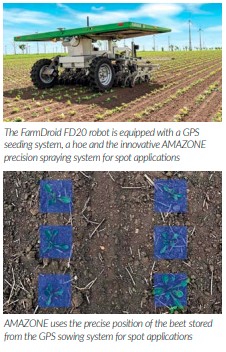
AgXeed and the establishment of autonomous processes
In addition to BoniRob and FarmDroid FD20, the automating of typical work in the field is an interesting topic for the future. In this respect, the autonomy of connected implements and the work required from these implements is the key development issue for Amazone. In contrast, the autonomous tractor is better left in the hands of the tractor manufacturers or specialised start-ups. As of this year, Amazone has been cooperating with AgXeed, a start-up from the Netherlands. In Amazon’s view, AgXeed’s experienced team of developers has chosen the right technological and systemic approaches. The key issue for AgXeed is the commitment to create standardised interfaces both in the mechanical coupling of machines and in communication via ISOBUS. Ultimately, the customer should have the freedom of choice for the best implement on the best tractor unit, which is normally the case today and produces the greatest innovative power. This should be the same for robotics too.
From automation to autonomation
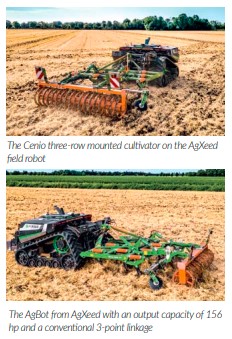
Automation and monitoring must be perfected, in order to be able to use implements without human supervision. Amazone has been pursuing the automation of processes in the machine for many years. Examples of this include the ComfortPack plus automatic cleaning system in the sprayers, monitoring of the spreading quality with ArgusTwin or the AutoPoint system for the precise switching of seed drills at the headland. It is not yet clear which machines will be the first to take the step from automation to autonomation. Apart from the technical and legal challenges, the primary question concerns the customer segment in which an economic advantage will become apparent.
Autonomy in the Controlled Row Farming system
In 2020, Amazone started new longterm field trials together with its subsidiary Schmotzer Hacktechnik and its partner Agravis. The Controlled Row Farming (CRF) trials at the new test centre in Wambergen, close to the production site and main plant in Hasbergen-Gaste, will contribute important findings to new crop production methods in the coming years. With a fixed row width of 50 cm in all crops, the sensitive inputs of fertiliser and plant protection are reduced through precise placement. An additional goal is to increase biodiversity in the field and to keep the economic success of the farm at least constant. The first harvest results confirm a constant yield, also in cereals in a double row with a spacing of 50 cm. The results can also be found at www.controlled-row-farming.de.
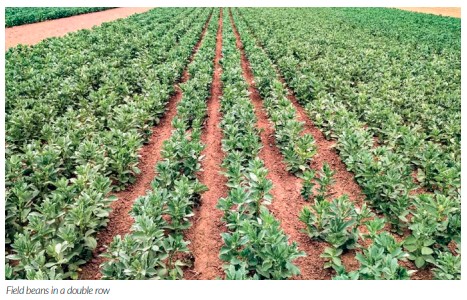
In an illustrative economic analysis of the CRF system for a farm with 300 ha, it becomes clear that the reduced costs for the inputs are offset by the increased costs for labour. Apart from the purely economic consideration, the additional work time required in the main season is a critical point: 476 hours/annum are required for fertilisation and plant protection in conventional arable farming compared with 706 hours/annum (+ 48 %) in the CRF system. In times of a shortage of skilled labour, this factor is critical in the short term. Autonomous agricultural machinery in the CRF system could undertake the labour-intensive tasks for the farmer in the medium to long term. The clear structure in the track guidance and cultivation system suits the robotic systems in any case.

Today, the CRF system is operated with conventional RTK-guided tractors, intelligent connected implements and an attentive driver. It is easy to imagine the use of autonomous field robots for this in the future. Every step of the process would be closely monitored. Slower speeds with smaller working widths and completion of the tasks with even more precision are then also conceivable. Ultimately, the farm manager will have to spend less time monitoring standardised work processes and be able concentrate on other tasks.
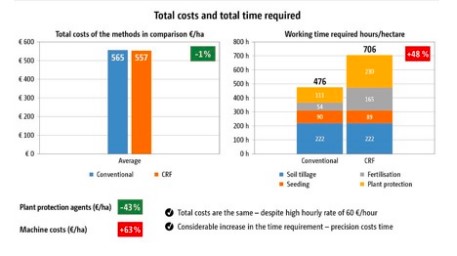
-

Drill Manufacturers In Focus…
Horizon CEO George Sly writes “What a year it’s been! We have continued to grow and develop quickly during
extremely challenging times for the manufacturing sector.
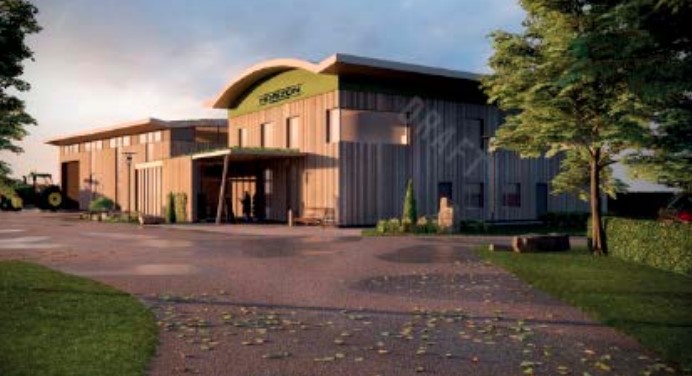
We have made some big strides in 2021 and have a lot of exciting things happening in the next 12-24 months! When we launched Horizon, we had an extremely tough decision to make, with Brexit looming – do we manufacture in the UK or in Europe? Our decision to stay in the UK is something we are very pleased with, despite some inevitable challenges along the way.
We are proud to fly the ‘Made in Britain’ flag and to employ local people in South Lincolnshire. Approximately 78% of our components are also sourced in the UK, so when you buy Horizon you really are buying British!
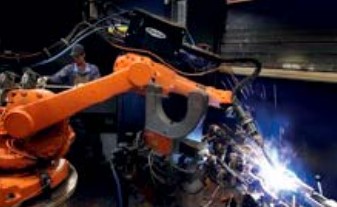
What’s on the Horizon?
Plans for a new 11 hectare site, featuring a manufacturing facility and R&D centre are in the final stages. This will be the largest seeder / planter manufacturing site in the UK in terms of output and will operate a linear production system incorporating LEAN manufacturing principals. Production will sit alongside our R&D centre, which will also house our engineering team. The site will be unique in that crop trials, R&D and production will all take place on the same site. As part of the new production facility move, we will be launching a range of 9-12 metre machines in 2022 to begin production for 2023. Further details will be revealed in the 2nd quarter of 2022.
UK Dealers announced!
We were very happy to welcome our new Sales Manager – Charlie Eaton to our team earlier this year. Charlie has been busy building our UK sales network, with 3 key dealers joining us to date – Smallridge Brothers in the Cornwall, Devon and South Somerset, Redlynch Tractors in North Somerset, Wiltshire and Dorset and RES Tractors in Leicestershire.

Automation
Whilst we are extremely proud of our 40 strong workforce, like any other business, it’s imperative that we look to evolve and to identify opportunities to increase efficiency. As we strive to be the leading European manufacturer of premium planting / seeding machines and tools for regenerative agriculture, we are investing heavily in our future, in order to compete with the larger European OEM’s.
Welding: We are about to take delivery of ABB Robot cells to automate around 65% of our welded components, this ensures repeatable accuracy, quality and efficiency. Parts Storage: As we all know downtime is something no farmers want. For this reason and to improve our internal efficiency we invested in two automatic storage systems. These systems can store a total of 90,000KG of parts or up to 35,000 lines, all of which are accessible within 8 seconds. The systems allow us to process a parts order in less than 4 minutes from order to packing. They are linked to our ERP software allowing us to send orders to be picked remotely
Introducing: The 3 C’s – Clearing, Cutting, Closing
All our row units have to perform 3 tasks:
• Clearing resude ahead of a disc opener or tine
• Cutting the soil evenly and to uniform depth to place the seed
• Closing the furrow assuring optimum seed to soil contact for even germination
As we delve depeer into the technology in our products and release more information on how each component gives you a return on investment you will see much more of the 3 C’s in the future! We hope you like it as much as we do!
-
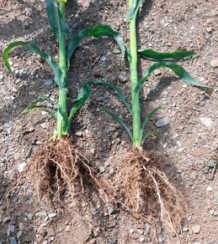
High Fertiliser Prices Focus Attention On N Input Efficiency And Soil Health.
Written by David Newton – Technical Manager, Timac Agro UK
The current fertiliser production and supply issues are leading to producers examining their inputs and expenditure, looking at the returns on their investment and the opportunity to enhance the effi-ciency and return from every kilo of input.
One way to help the soil regain balance is by using a soil conditioner. These are often based on the addition of calcium to soils, sometimes mistaken for liming, along with other trace elements and biological stimulants to help the soil heal itself. Liming is the addition of Calcium Carbonate to mop-up excess hydrogen ions-acidity, whereas soil conditioning, while buffering pH on a local level, also aims to improve soil structure, air and water flow, soil biological activity and, through this, nutrient availa-bility.
Two such products are Physiolith and Humistart, both based on a marine calcium base “Calcimer”; a highly reactive source of soluble calcium carbonate rich in essential trace elements that rapidly buff-ers any surface acidity, binds clay and humus to strengthen structure and regulate water flow, pro-vides a safe haven for soil microbes and can counter excess Mg & potash effects. Add into this a sea-weed-based rooting cytokinin and you have Physiolith; a great stimulator to improve crop establish-ment and rooting. The biostimulant in Physiolith also opens up nutrient uptake pathways generating more vigorous growth and healthier plants to strengthen establishment and return value for money.

In more established crops, or situations with potential for utilising OM, (min/no till, manure/compost additions, long-term grassland) Humistart may be more applicable. In this product the biostimulant is aimed at feeding soil life and stimulating fungal growth. The Minactiv biostimulant, again seaweed derived, targets the mineralisation of organic nutrition, especially where any tough, lignified material is involved. So breaking down cover crop, straw-based manure, wood-chip or high C-N ratio compost at temperatures down to 2oC to release “free” nutrition.
“In these times when we are examining every input, a soil conditioner can complement a lower input regime to reduce compaction, stimulate soil health, buffer pH and generate good returns” says David. “But I have a calcareous soil! Why would I add more Ca when it is locking up nutrition?”
It is all down to reactivity and roots! The highly reactive Ca in Calcimer works to produce stable aggre-gates even in calcareous soils, improving structure and reducing salt build-up. “at Timac we have done research into the effect of root density on local pH” says David: “Root exudates are mildly acidic, so it follows that if you increase root density you increase the concentration of exudates reducing the pH of the rhizosphere, this can be up to 1 pH point, so releasing locked up nutrition such as phosphate, so stimulating root growth not only finds more nutrition, it releases more from the soil”
“Soils have taken a battering, much like the agricultural industry for many years now, it isn’t the farmer’s fault, they have just been following the best advice of the time” says David, “however awareness of soil biology and interactions has improved so we need to farm differently now, the fertiliser price increases have forced growers to look at their input and consider their practices, hence the growth of regenerative farming, min/notill practices and soil conditioning”
What is the current situation?
The commonly used fertiliser materials that, in recent years, have been in plentiful supply and relatively cheap: Ammonium Nitrate, DAP, TSP, MOP work on a principle akin to the “carpet bombing” approach of the 1940s, 50s, 60s and 70s warfare; i.e. throw enough nutrient into the system and some of it will hit the target species. Unfortunately, as with Carpet bombing there is “collateral damage” of soil health, plant health, weed growth and reduced fertility that have led to a dependency on further chemical solutions. To mix metaphors, nitrate fertiliser is the “gateway drug” to dependence on the fungicides, herbicides and growth regulators that have been profitable for the Agronomy industry over the last 40 years. The focus on sustainable productivity, Carbon footprint reduction and the rise in input prices lead us to question this approach and look at ways to a more “precision strike” method of nutrition.
Is it time to try something different?
Fertiliser formulation has moved on from the simple commodities to include extra technology to en-hance nutrient uptake efficiency, plant physiology, the delivery of the nutrients involved and enhance soil health to add sustainability into the nutrition system. For the last 40 years Timac Agro have been at the forefront of this enhanced fertiliser offering, developing soil conditioning phosphate and nitro-gen solutions that protect and improve (rather than disrupt) soil health with their soil conditioners, Physalg, N-process and a totally new phosphate, Top-phos ranges. These products utilise natural seaweed and humate technology to package nutrition in ways that pro-tect it from pH lock-up, leaching and volatilisation, working with the natural nutrient uptake processes of roots to deliver nutrition to plants in ways that promote both plant and soil health.
By including marine Calcium (from seashells), Sulphur and magnesium, elements demonstrated to have a synergy with nitrogen uptake, bound with the N-sources at a molecular level in their N-process molecule, Ti-mac nitrogens provide an ideal early-season application in all commercial crops to get the season off to a healthy start. The company is unusual in that it recommends rival products such as CAN for subse-quent applications due to the (usually) high price point of their inputs. This year is the exception as explained by James Hay, Deputy Manager of Timac Agro UK:
“Due to the nature of our manufacture process we are less subject to the fluctuations of the com-modity market and, although we have also experienced price pressure, our rises are considerably less than those experienced by the commodities such as Urea and AN, bringing us into line with and in-deed cheaper than some of the prices being circulated currently”
David Newton, Timac Agro UK product manager explains how they can help with the current price storm:
“by including soil conditioning technology in your fertiliser program this year and in years to come you will increase overall efficiency in nutrient uptake, a healthy soil, balanced for pH, will respond in a far superior way to all inputs, be they from manure or chemical sources, the future of nutrition must listen to the needs of the plant and soil to give sustainable, intensive agriculture. For example, one of our customers, utilising soil conditioning and N-pro in their program, have brought the N-input down from 250kg/ha to 180kg/ha over the course of three years with now yield penalty. With the current fertiliser market you can’t afford to ignore these opportunities”
“We have been talking soil health and input efficiency for many years now, the current changes to payments, fertiliser market and emphasis on soil health and productivity means that our message is more relevant than ever”
Another approach to getting the best from your soils is to make sure they are in peak condition. Nu-trient availability drops off considerably in adverse conditions, readers of Direct Driller are all too aware of the issues caused by:
• Low or High pH
• Compaction
• Low OM
• Poor water flow (too fast/slow)
• Imbalance of elements, excesses of one nutrient can severely affect the availability of others.
• Over tillage
All of these conditions above will affect the chemistry and biology of your soils, and, for optimal plant growth the soil needs to be balanced to allow the science to work. “At Timac we work with farmers to examine their particular situation, dig and test soils, look at crop-ping and establishment to see if there is anything inhibiting optimal growth. We focus on long term improvements, not just instant, short-term fixes to deliver sustainable growth in so many ways”

-
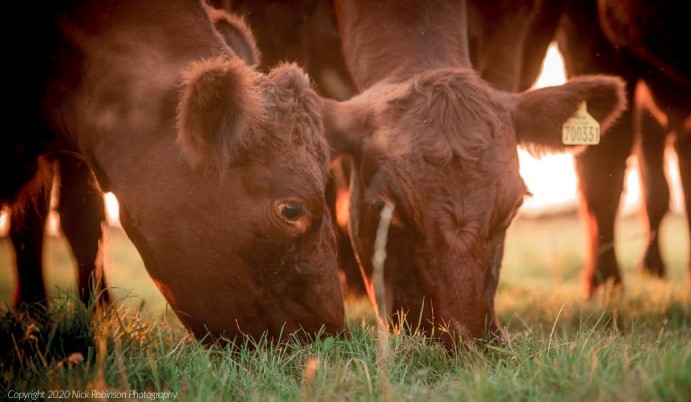
Methane And Carbon What Should UK Farmers Do?

The standout pledge at COP26 for farmers was the target to reduce methane emissions by 30% by 2030. Eyes, as usual, turned to ruminant production. We know that agriculture is responsible for around 40% of total UK methane emissions, with most of those associated with ruminant livestock and livestock manures.
But the picture is more complicated than simply eradicating ruminant production – and I believe we need to bring arable farmers into the picture when we look at reducing emissions from livestock farming. We need to look at the level of meat and dairy consumption that is appropriate for our health, what production systems we should transition to, and make sure that we consider the potential benefits of some productions systems for nature restoration.
At the Soil Association we call for a less but better approach – we should eat less meat overall, and what we do eat should be of a higher quality. For this, we need more mixed farming, bringing more livestock into arable rotations. This leads us to the “Ten Years for Agroecology in the UK” agricultural model, which defines a clear pathway towards an agroecological farming system for the UK. It recognises that the UK has a production advantage in ruminant product production, in terms of weather and appropriate agricultural land. Adoption of such a farming system across the UK would see us able to reduce overall emissions by around 40% (before any additional sequestration activity through for instance tree planting). This model includes key assumptions around future diets, future use of artificial inputs, and that much more mixed model of farming.
Manures from animals would help us to reduce nitrogen fertiliser, which we must do if we are to reach net zero. At the moment some 43% of total emissions from every loaf of bread we eat comes from the artificial fertilisers used to grow wheat, so we can’t ignore this problem. We also need to find ways to bring legumes into crop rotations in a way which makes them profitable to grow – including peas and beans more in livestock concentrate feeds as well as eating more of them ourselves. If this were possible then farmers could routinely adopt legumes as break crops and fertility building crops.
Alongside such changes, it will be essential to revisit how we select crop varieties in future, and this begs the question about the place of yield as a key trait for selection in future. Increasingly we might wish to move to maximum sustainable output for any given land area under any given crop. This would identify the optimum output possible without reducing the area’s natural capital (over a rotation length). Such a change would greatly change the traits required and internalise those externalities of production which are currently picked up by society, or by consumers who choose to purchase products from farmers who have internalised those costs, such as organic farmers.
Alongside these changing imperatives for farm businesses to reduce greenhouse gas (GHG) emissions there is also the new voluntary market for soil carbon to consider.
The new voluntary market for carbon
Although the voluntary carbon market has been around for more than 20 years, there is currently huge interest in the sale and purchase of landbased carbon credits as offsets. This interest is because the net zero policy agenda has ramped up significantly over the last 18 months, with many organisations and companies making net zero emission commitments and needing to deliver on them. Almost all these net-zero strategies plan for continued carbon emissions, that need to be offset by compensatory carbon credits (offsets), to achieve the stated net zero target. There is increasing debate around this, as it is becoming clear that emissions reduction is the key requirement rather than paying a third party to sequester carbon whilst continuing to emit at the same level. As a consequence of this, the focus on supply chain emissions is coming to the fore, with retailers committing to support reductions in emissions from their supply chains. The latest of these being one multiple retailer supporting chicken farmers to produce insect protein from food waste to replace imported soya in poultry diets, thus reducing the potential for deforestation, one of the largest sources of worldwide GHG emissions.
At the moment in the UK, the majority of voluntary carbon offset projects are provided by afforestation via the Woodland Carbon Code, followed by peatland restoration via the Peatland Code. These voluntary standards were established to provide guidance to project developers to deliver high integrity carbon benefits and assurances to voluntary carbon buyers that the climate benefits they purchase are real, quantifiable, additional and permanent. Standards are now being developed in the UK, funded by the Environment Agency’s Natural Environment Investment Readiness Fund, including the creation of a proposed UK Farm Soil Carbon Code to reward farmers for the carbon sequestration benefits of more regenerative practices. At the moment there is no common UK agreed code, leaving scheme developers to develop their own, resulting in a range of different opportunities for farmers. Most, if not all, schemes are focussing on arable farmers with opportunities to sequester carbon through increasing below ground productivity and reducing removals of above ground biomass; adding external sources of carbon (soil amendments); reducing soil disturbance; maintaining high water tables and minimising soil erosion. Schemes for grassland farmers are less common, mainly due to the need for additionality over current farming practice.
The practice which has the greatest capability for sequestering carbon s directly increasing the amount of biomass in the system through, for instance, adding hedgerows or trees. Again, the key tests are real, quantifiable, additional and permanent. These terms and their precise meaning are causing much debate. Take for example permanence: In the ideal offset project, reversals of carbon emissions are physically impossible or extremely unlikely. Standard convention in offset markets has been to guarantee that carbon is kept out of the atmosphere for 100 years. Yet, this is not practical for soil carbon, which is considered as “shortlived” storage carrying a higher risk of reversal. In the USA, Nori manages permanence by offering short-term credits that expire after 10 years. In Europe, Soil Capital has a 5-year crediting period, in which farmers can earn and generate credits, followed by a 10-year retention period. Carbon Farmers of Australia must choose between 25- and 100-year permanence guarantee. Without an agreed UK farmland soil carbon code, different definitions and offers are being developed in the UK and farmers should be aware of what they are signing up to before committing.
As retailers start to move to make good on their commitments to net zero, inevitably farmers will need to be able to demonstrate their credentials in terms of net zero. Farmers who have developed their own on farm mechanisms to reach net zero will need to be able to evidence these robustly, but it will potentially make them more attractive suppliers. However, if such a farm chose to sell carbon offsets, the carbon sold is removed from their balance sheet to appear on that of the purchaser. This could render the farmer a high emissions producer and hence less attractive to product customers. This needs to be considered when entering into any carbon offset agreements.
The quality of schemes also relies on the accuracy of soil data. Some schemes rely on regional data whilst others require field soil samples down to 50cm of more. The more granular the data the more accurate the picture on soil carbon levels should be. Taking soil samples requires attention to a number of features including timing, field selection, within field sampling, number of samples per field, depth of sampling and frequency of sampling. These features need to be standardised to provide consistency of results, which is necessary for entry to carbon markets.
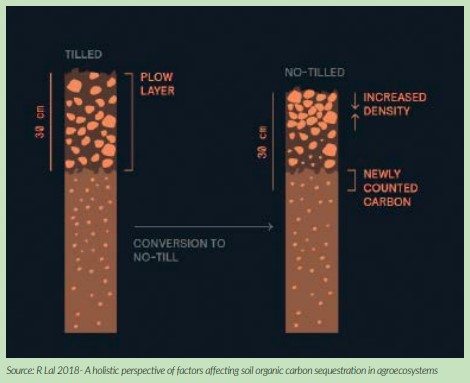
The final question is to ask how best to test for carbon in soil. The three most common ways are loss on ignition (LOI), dry combustion (DUMAS) and potassium permanganate oxidation. LOI is the most common due to its traditional usage in evaluating the organic matter content. DUMAS is the most accurate and direct measure. Potassium permanganate oxidation (sometimes; permanganate oxidisable carbon (POXC)) is another way of characterising organic matter. It is less common and indicates “active carbon”. Although this is an informative quantity, if only one method is to be used, we want to measure all organic carbon that is built up and stable for the long-term. Each method has its own advantages and disadvantages for different soil types, budgets and uses.
The density change effect
The volume of soil carbon in any given area of soil depends on both the soil carbon content and the soil density. Changes in soil density can affect estimates of carbon storage, even without a change in the amount of carbon stored in the landscape. Shifts between conventional tillage and no-till are a classic example of this accounting problem.
Soil density leads to a depth-related effect on net carbon storage alongside the redistribution which occurs when tillage is practiced. This can lead to overestimation of carbon storage under no-till relative to conventional tillage. This potential source of bias is easy to correct for with the right sampling approach, though few soil carbon protocols currently account for it.
Tillage breaks up the soil structure, essentially “fluffing up” the soil and reducing its density. Conversion to no-till allows the soil particles to settle into a denser structure. As a result, the plough layer of no-till soils is on average roughly 2-3% denser than the plough layer of tilled soils. The difference in soil density under no-till versus conventional tillage can affect carbon stock estimates. The table below illustrates this. On the left, a field is sampled to a fixed depth of 30 cm and carbon stocks are calculated at that depth. After conversion to no-till, the density of the plough layer increases, shifting the soil surface downwards slightly. If soil is then collected to the same depth, soil particles that would have been left out before are now included, leading to a larger carbon stock estimate. This larger carbon stock estimate would be entirely due to changing the frame of reference for sampling.
This emphasises the need for a detailed protocol which all farmers can follow when taking soil samples. The Farm Carbon Toolkit Soil Monotiring Guide recommends it includes protocols for the following areas:
• Timing: Spring or autumn are more suitable for field access and sampling ease; the most important factor is consistent sampling the same time each year
• Field selection: Choose fields which best represent current and historical land use and try and represent all soil textures across the farm
• Within field sampling: Make the sample as representative of the field as possible i.e. the main cropping area. Across this area sampling can be carried out in a straight line, W shape or grid pattern. If accuracy and precision are important and the sampling is to be repeated in future years, it is important to GPS log the sample points across the field
• Characteristics of the samples taken: A minimum of 5 sample points per field are recommended, but preferably 15 sample points will increase accuracy. Sampling is recommended to 30cm deep. This allows the assessment of the carbon that is held at depth and is therefore less likely to be released. It is recommended to carry out analysis every 3-5 years
The UK Farmland soil carbon code seeks to address the current lack of clarity for farmers in this new, evolving, voluntary carbon marketplace, including soil sampling testing and analysis protocols, and it cannot come soon enough. For now, though, the watchword for farmers has to be to look very carefully before entering into any agreements to sell carbon offsets.
Ask yourself – If I enter this agreement, what claims will I be able to make about my farm carbon footprint in the future? does the scheme have a transparent, robust methodology on permanence, additionality, measurement and verification? and am I happy to be doing business with the credit buyer?
-
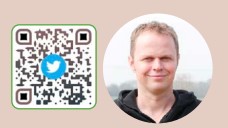
Farmer Focus – Andy Howard

Every year you learn something new and the last two years have been tough, and we have learnt a lot! This shows in our machinery purchases over this period. We have bought a mole plough, a drain jetter, a set of rolls with paddles and a Tech Neat Outcast catch crop spreader. These are all linked as I hope they will all allow us to cope better with increasingly wet autumns.
Our heavy clay soils are always the fields that cause us the most issues in No Till. We have managed to improve the soil structure over the years, but a slow permeable clay soil will be a slow permeable clay soil, no matter how good the soil structure on the top is. We needed a method to get the water away from the surface faster, with low disturbance and benefits which last longer than 2 months, unlike subsoiling. This led us to purchase a mole plough in February 2020 and it seems to have been very successful this autumn. Mole ploughing is not that common in Kent, in this sense we are behind our neighbours in Essex, I will give them that one thing!!
The Drain Jetter was used extensively last winter, we found a lot of drains we did not know existed and improved a lot of existing ones that seemed to be running OK, but a lot of silt still came out of them while being cleaned. Our new set of rolls were bought with paddles just to help close the seed slot in certain situations. These situations were normally in the spring or after grass. We have modified the paddles, so they are not aggressive and do not bulldoze residue. We have also learnt this year that growing winter beans after herbage seed crops is safer than growing spring beans (see beans after grass). The winter beans are not affected by the grass pests as much as spring beans are, due to the pests like leatherjackets not feeding in the autumn. We have had excellent establishment this autumn.
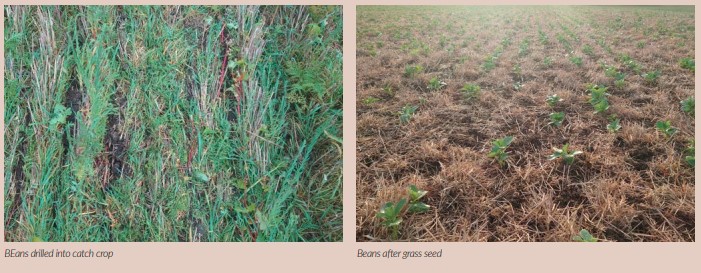
The Outcast Spreader was bought second-hand this summer and I used it to spread catch crops into standing crops this summer, some were successful while some failed. The lessons learnt for next year is that we need to increase seeds per spread, add some slug pellets, and narrow down the species spread, as some species seemed to be a waste of time. Catch crops I believe are our missing link in terms of having constant living roots. One big advantage is that catch crops make drilling later in the season far less risky compared to planting into bare stubble. (See catch crop picture)

We are also involved in a trial this autumn with Southern Water as they are looking to reduce the amount of Propyzamide in the local watercourses. The two methods we are trialling are catch cropping pre-drilling to smother weeds and reduce run off (the main source of propyzamide) and growing oats with the winter beans with the aim that the oats will reduce the weed burden in the beans. We need to learn how to reduce this type of pollution, otherwise it will be another herbicide we lose. It will be interesting to see the results.
This autumn the crops look in good order with lots of potential for next harvest, the dry autumn has been a pleasant change! Wishing everyone a Merry Christmas.
-

Capture The Full Value From Your Soils
Written by Tom Allen-Stevens from Trinity Agtech
New markets have opened up for carbon and biodiversity. When underpinned by digital software, international protocols and a just legal framework, they allow those who manage the land control over their natural capital and the income stream that’s opened up. Louisa Knocker from Trinity Natural Capital Markets addresses the queries.
Winter is a time of year when the differences are laid bare – quite literally in some respects. For those following regenerative agriculture, your fields are green, with a gratifying cover of biomass you’ve been careful to establish and cultivate. The ground walks firm – you can almost feel the thriving network of roots and the life they support beneath your feet. Your streams run clear, despite the heavy downpours that cause your neighbours so much grief and wash clouds of their soil and nutrients into the rivers and tributaries beyond your boundary.
But do you see this difference as a tradable asset, and are you adequately rewarded for the care you take with the resources you so skilfully manage?

Carbon credits, with or without biodiversity and water protection cobenefits and biodiversity tokens are now clear and credible opportunities for farmers. The Environment Act has set legislation around the Government’s 25- year plan to leave the environment in a better state than they found it. This paves the way for a renaissance in the fortunes of the rural economy based not only on what the land produces, but how it’s managed.
Trading in the voluntary carbon market alone is predicted to be worth £40bn by 2030. But it’s a young, nascent market, open to inefficient and unfair trading. As such it can be difficult to know which deals will truly be in the best interests of those who care for their soils, and which will result in a corporate land grab, with good farming land covered in trees or left to rewild. There are also genuine concerns for the commitments these trades will bind the land to – whether these will result in farmers losing control of the way they manage their soils, and how tenants and contractors can be fairly rewarded for the work they collaboratively undertake with landowners.
Farmers who manage their natural assets through credible decision-support assistants will be the ones who retain control. Those who work through a rigorous and efficient digital market will reap the rewards. This will have the templates, model contracts and legal framework expected of any financial market for a fair and virtuous outcome for everyone’s collective gain. It’s the route that will ensure the best interests of the soil are a key outcome of current changes and will contribute to lasting, positive change for farming.
What is the opportunity?
The natural capital markets are driven firstly by the need to reduce emissions and keep global warming below 1.5°C. Coupled with this, the need to halt the loss of biodiversity has been enshrined into policy. While it’s incumbent on everyone to reduce emissions, there are some aspects of society and the activities we undertake, such as air travel and building houses, that will always carry a carbon or biodiversity cost. That makes natural climate solutions tradable commodities.
Meanwhile in the investment world, carbon markets are rapidly emerging as a very relevant and viable asset class for institutional and other major investors. More than 50% of global GDP depends on nature – an estimated £33 trillion – and 90% of natural capital is lost due to human behaviour. Already 25% of the world’s 500 largest companies have made carbon commitments by 2030, creating a voluntary market for natural climate solutions in the UK set to far outstrip the value of the wheat market.
But currently it’s still fragmented, insufficiently small and lacking in standard transaction processes, pricing mechanisms and transparency. Investors need authenticity and confidence in where to put their clients’ money. As a result, a major piece of work is being done by the Taskforce on Scaling Voluntary Carbon Markets (VCM) to grow the market, bringing trade that’s verifiable and environmentally robust. To ensure sellers can market their credits on a platform they trust, and buyers can find genuine, verified carbon credits, Trinity Natural Capital Markets (NCM) has been created. This new platform is aligned with the principles of the VCM taskforce’s recommendations and embodies the traits essential for fair, efficient and ethical transactions.
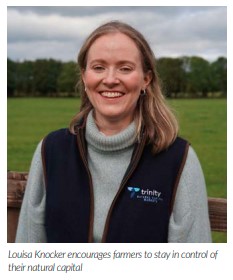
Do you have to reach net zero to trade? Unlike other industries, agriculture is unique in that it can sequester carbon and boost biodiversity. But there needs to be an economic rationale for the sector to reduce emissions and reach net zero to start to make this positive contribution. Certain companies are voluntarily willing to reward farmers to both reduce emissions and remove carbon. This may be those that deal direct with farmers and wish to contribute to tackle the climate crisis, beyond reducing first their own business emissions. Trinity NCM makes a distinction between reduction and removal credits, rewarding farmers for both. Reduction credits are for lowering emissions, such as through reducing use of synthetic fertilisers. Removal is for permanently sequestering carbon, such as through agroforestry or reducing tillage. You have to be reducing your overall carbon footprint to claim the credits, but can start to do so before you reach net zero.
For many direct drillers, however, net zero is a target they have already accomplished. Trinity NCM recognises this and also makes provision for the added societal benefit those growers bring through maintaining their carbon stock. Not only that, there are extra rewards for those who continue the good work towards a natural equilibrium in their soils.
How does it work?
When managing the aspirations of large corporate investors, it’s important to attractively package up what you have to sell. In this case that’s your natural assets – not just carbon, but biodiversity and water quality, too. This means investing in a decision-support system that helps you with designing your sustainability path and scientifically calculates your carbon credits with or without biodiversity. This then allows you to articulate what you have to sell on the open market.
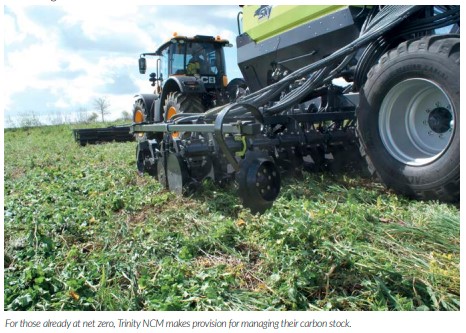
Sandy by Trinity AgTech has been designed to do exactly that. It’s a piece of software – a digital assistant – that puts you in control of your natural assets, quantifying what you have in your care in the same way your profit and loss account and balance sheet assess your financial assets. Importantly, it frames your natural assets in a way investors can relate to. Sandy leverages the credits, and the credibility, to be a trusted partner of institutional investors and asset managers. Then through a well-aligned and rigorous marketplace – Trinity NCM – you can trade transparently and on your own terms. We’ve developed a process to help farmers through this journey, known as Trinity’s 7 steps. A key aspect is to establish your farm’s baseline, and Sandy does this by drawing in data from your farm management software on how you manage your soils. This means the very first step is to learn to love your data – the natural capital market is entirely digital, so the more digitally aligned your business, the easier it will be for your achievements to be recognised and rewarded.
That doesn’t mean relinquishing control of the data, though – it’s your data and will always remain so. Trinity AgTech and Trinity NCM are governed by a robust data ethics framework that allows complete control over whom the data is shared with. We’re also independent, designed with the interests of farmers and have no corporate backers, affiliations or shareholder interests that could distort our values nor our mission.
How are the credits assessed?
Just how natural capital should be evaluated is a topic of much debate. A Scientific Board of 35 of the country’s leading experts in this field oversee and review the criteria Sandy uses to determine this. For carbon, the methodology is a compilation of IPCC (Intergovernmental Panel on Climate Change) models coupled with peerreviewed emission-factor databases. It’s compiled and harmonised by the board with reference to their experience of modelling agricultural emissions, and to ISO standards.
For biodiversity, the methodology and its compilation are carried out by 17 of the foremost experts in the country. Both the evidence-based studies used and the modelling undergo peer review by the scientific board to ensure valid results, whatever land-use type. So the baseline assessment, which determines your carbon credits and biodiversity tokens, is established from farm and field management data, drawn from your records. This has been found to give a far more accurate picture of a farm’s biodiversity counts, water status and carbon levels than spot surveys. The assessment can be refined by adding in actual data gathered, although the caveat here is that poor data can skew the results.
How do you combat Greenwash?
Once you’ve assessed your baseline, Sandy helps you generate a plan to reduce emissions, sequester carbon and boost biodiversity, so you can trade the credits and tokens you’ll generate. But you may not want to go to the effort if the credits generated are wasted on emissions from third parties that you feel shouldn’t have been made in the first place.
Options available through Trinity NCM put you in control of who receives your credits:
1. Sell on the open NCM marketplace by setting a minimum price and wait for suitable bids to come in.
2. Sell to corporate investors, a prequalified buyer, whose price and criteria you agree with.
3. Use the credits to sell or barter with businesses you already have a relationship with such as processors, retailers or other land managers.
What are the legal implications?
It’s necessary to address first of all who owns the natural capital and has the right to trade the assets. Trinity NCM model contracts have been carefully put together to provide flexibility and transparency. This ensures harmonious legal and contractual underpinnings between landlords, tenants and contractors, as well as fair governance and delineation of the different activities that may be undertaken.
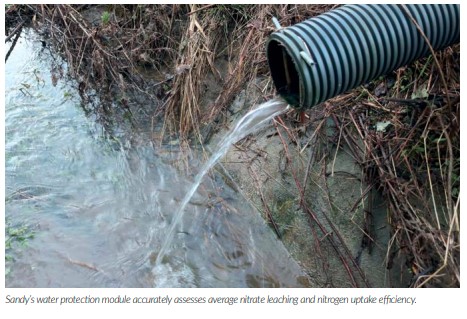
Carbon credits and biodiversity tokens are traded on the basis that you undertake to reduce and/or sequester carbon. This commits you to a contract that can go for one year up to 20 years, but again there’s flexibility and protection built in. You can’t sell carbon credits until the carbon has been removed from the atmosphere, in the case of removal credits, or you can show that it hasn’t been emitted, for reduction credits. While reduction can’t be reversed in the year it occurred, removal can, through cutting down trees or ploughing land, for example.

If the reversal is intentional, such as ploughing up land following a change in farm policy, the whole contract is cancelled and any unsold credits are not marketable. The seller will be liable to release funds held in an escrow account. A reversal can also happen through an unintentional event. For these circumstances, a buffer pool of your credits is retained in your Registry, which accounts for a proportion of the removal credits identified by Sandy. This pool of untraded credits is drawn down should there be unforeseen weather events, for instance, that cause a change in farm practice – quite literally your rainy-day fund.
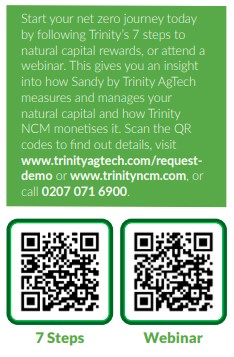
-

Drill Manufacturers In Focus…
SEE & SPRAY™ NOW IN USE ON FARM

John Deere introduced See & Spray™ Select in March 2021, with machines available factory-equipped with advanced spraying technology. Farmers can use See & Spray Select, to minimize input costs and only spray weeds when they are detected. It puts an end to broadcast spraying.

See & Spray Select uses camera technology to detect color differentiation in the field and is ideal for small-grains farmers who manage weed pressure on fallow acres. As the sprayer moves through the field, its cameras rapidly detect only green plants within fallow ground and triggers an application to those plants. See & Spray Select has a similar hit rate to broadcast spraying2 while applying 77% less herbicide on average1. This opens the opportunity for farmers to save on their non-residual, pre-emerge herbicides. Joel Basinger, marketing manager for John Deere stated that research has shown that weeds sprayed with complex tank mixes with more than two modes of action are 83 times less likely to develop herbicide resistance.
Built on a 400 or 600 Series Sprayer and factory equipped with See & Spray Select, it is the only OEM solution available that enables farmers to have both a spotspray and a broadcast machine in one integrated package. This helps you cover more acres per day because you’re not stopping as often to refill. This technology is available on newer John Deere 400 and 600 Series Sprayers, which includes the 408R, 410R, 412R, 612R and 616R. If the job requires it, you can easily switch to broadcast spraying without leaving the sprayer’s cab. When finished with fallow spot-spraying and a post-emerge broadcast application needs to be made with the same tank mix, John Deere ExactApply technology can be used and can save up to 5% in broadcast chemical costs.
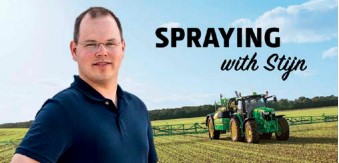
Sprayers come from the factory with fully integrated precision ag technology that delivers important data farmers and operators need to make informed agronomic and equipment decisions to benefit their operation. Data is collected in the John Deere Generation 4 Display and streamed via the JDLink™ connection to the John Deere Operations Center where it can be analyzed. This spot-spraying is only the beginning of the John Deere See & Spray journey as we help transition from field, to zone, to row, and now to individual plant spraying. John Deere continues working on future solutions that will meet additional customer needs beyond See & Spray Select.
Follow the progress of sprayer technology on farm in Denmark, where farmers have been using spot spraying maps for their wheat herbicide application for the first time. Watching from the cab they have been able to see individual nozzles being turned on and off based on the application map data. The first results look encouraging, no missed weeds and significantly reduced amounts of herbicide. The “Spraying with Stijn” series can be followed on social media.

-

Nuffield Scholars

The Nuffield Farming Scholarships Trust announced their newest cohort of Scholars in October, many of whom will study topics related to soil management, sustainability, and regenerative farming practices.
“This year’s intake represents a significant change in direction that British agriculture is and must take to ensure a sustainable farming future,” says Mike Vacher, Nuffield Farming Director. “Many of our 2022 scholar’s topics are centred around reducing inputs, regenerative principles, improving efficiency, and mitigating climate change in order to help achieve Net Zero.” “The future of agriculture needs forward-thinking and innovative leaders. This year’s scholars have been selected for demonstrating these traits and the clear passion they possess for their chosen topic.”
Six of the 2022 Nuffield Farming Scholars share their backgrounds with Direct Driller and elaborate on their plans for their scholarship journeys…

Arable Farmer, H Sutton & Son North Yorkshire
I am a third-generation farmer working on the family farm near Filey, North Yorkshire. We grow a diverse range of cash crops over an area of around 450ha, with 200ha of this being potatoes on largely rented land. Since returning home to the farm, I have been interested in regenerative agriculture. We are currently transitioning from a min-till to a no-till, regenerative combinable system, however doing so with potatoes poses a very unique challenge. During the past season, we have seen increased yields in our reduced cultivations trial, as well as decreasing the frequency of passes to apply fungicide through a focus on nutrition. All positive signs, but we have a long way to go…
My Nuffield Farming Scholarship, sponsored by the Alan & Anne Beckett Award, will focus on exploring how maincrop potatoes can be grown in a regenerative system. I believe this is an incredibly pressing question in a world which has a growing demand for both potatoes and crops being grown in a manner less detrimental to both soil health and the wider environment.
To investigate this, I plan to travel extensively throughout North America, Europe and the UK visiting potato growers, past Nuffield scholars and pioneers of the regen ag world. By visiting these countries, I aim to learn about different establishment methods and the cultivations (or lack of) that were used. This could go a long way toward removing the deep tillage that is widely used in the sector, yet detrimental to soil structure.
We have found that by acting as an armour over the winter, cover crops enable us to cultivate less and reduce the amount of compaction faced in Spring. I believe there is huge potential in using cover crops before, or perhaps alongside, potatoes and would like to better understand how they can mitigate the damage done by the establishment and harvesting process. I will also be looking to gain a deeper understanding of how farmers are reducing reliance on artificial fertilisers and pesticides with a nutrition-first policy. I look forward to sharing my future findings with you!

Commercial Development Manager, Future Biogas Ltd Yorkshire
Bioenergy crops divide opinions especially within the agricultural community, however, is this stopping businesses from looking at the potential opportunity for their farm business? I plan to address this in my Nuffield Farming Scholarship ‘Bioenergy crops: An opportunity to address the Triple Bottom Line’, which is sponsored by the John Oldacre Foundation.
My career so far has focused on the agricultural industry, primarily in the arable, environmental, and renewable energy sectors. I have always aimed to help farmers build resilience during change by providing them with new opportunities, including reducing dependence on subsidies early on.
After many years working closely with farm businesses, I have realised that assessment of these projects can vary widely. In my experience, those who look at the wider benefits, including the Triple Bottom Line of ‘people, planet and profit’, tend to be more successful. By removing the pure profit driver and assessing projects as a whole, famers can move their businesses in directions they didn’t expect. Since starting at Future Biogas more than two years ago, I have seen the benefits of well-integrated, well-managed anaerobic digestion plants, and also experienced the common queries which occur from those outside the AD sector. This led me to look at why there is a perceived resistance to bioenergy crops in the UK and whether there is an opportunity being missed by arable businesses due to misconceptions.
When AD can offer non-commodity-linked and longterm contracts, inorganic fertiliser in livestock free areas, carbon sequestration in the soil, as well as permanent CO2 sequestration under the North Sea why is there still such a strong resistance to this cropping diversification? As part of my scholarship, I will visit countries at different stages of their renewable gas journeys to understand the views and experiences of farmers, local people, and the effect of policy decisions on the AD sector. It is important to understand how farmers in different countries have integrated energy crops, although accepting that climatic differences can play a significant role in those choices. Visiting world-leading Research and Development institutes and Universities to discuss new varieties and potential new energy crops will provide a fascinating insight into future developments.

Agronomist, Agrii Monmouthshire
Having not come from a family farm, I came into the industry open-minded and keen to further my knowledge. This led to me to attend Harper Adams University College to study Agriculture, with my placement year spent in Australia. It was here where my passion for soil health and controlled traffic farming was founded, and I went on to write my dissertation on the effects of controlled traffic farming and direct drilling on soil health. After graduating from Agriculture at Harper Adams, I was selected for the Co-operative Farms Management Trainee Scheme, which gave me a great insight into large scale arable farming. Since 2014, I have been working as an Agronomist in South Wales, Herefordshire and Gloucestershire. During this time, I have completed the BASIS Diploma in Agronomy with Environmental Management to ensure my knowledge is relevant and industry leading.
A Nuffield Farming Scholarship has been a long-term aspiration of mine and my study topic is “Do regenerative farming practices pave the way for UK farmers to meet Net Zero?”, sponsored by McDonald’s UK & Ireland. From my Scholarship, I want to understand if UK Agriculture can become more resilient, sustainable and environmentally sensitive – whilst also remaining profitable – by adopting regenerative farming practices.
My studies will focus on the major contributors to carbon emissions and address how we can change practices to mitigate these factors. I plan to travel to the USA, Canada, Australia, UK, France, Germany and Denmark, and I want speak to farmers (organic and conventional), agronomists, researchers and academics to ensure a thorough and broadminded approach to this issue. The main areas of focus will be surrounding nutrient management, rotation, cultivation strategy, cover cropping and livestock integration. I want to better understand how these influence and impact carbon footprints within agriculture and how we can use them to our advantage to meet the Net Zero requirements in the future.

Catchment Source Manager, Wessex Water Dorset
I’m an excited 2022 Nuffield Scholar and my topic is no doubt going to generate a lot of healthy debate and differing views: ‘How to create a local soil carbon market between farmers and utility companies’, generously sponsored by the John Oldacre Foundation. Always rooted in agriculture, I grew up in South Dorset milking cows, carting grain, etc. After studying a business degree, I trained as an agronomist and took up various technical and commercial roles within agriculture. Always passionate about the environmental side of agronomy, I now work alongside farmers informing, advising and incentivising them to create positive change to improve drinking water quality across Dorset, Wiltshire and Somerset.
At the moment, the soil carbon market feels like the Wild West, with both farmers and buyers cautious about getting involved – rightly so I think! It’s also moving at a pace that can be difficult to keep up with, and there are many difficult-to-answer questions pending. These will need to be answered for soil carbon markets to become better understood and less ‘greenwashed’.
My aim is to help the UK Agriculture and the utilities sectors best understand how they can work together to deliver their Net Zero commitments, while also leaving a legacy of improved farm business resilience to climate change and improved water quality. I’d also like to explore the challenges and barriers of transitioning to regenerative farming systems and how they have been overcome. Travel plans at the moment (subject to COVID!) include the United States, Australia, India, Europe and, of course, the UK. During my travels, I will do a global assessment of soil carbon markets, which means meeting with key stakeholders – including soil carbon buyers, sellers, brokers, investors, experts, accreditors, advocates, sceptics and farmers that have or are transitioning to regenerative systems. If you are one of these people or know one of these people, I’d like to hear from you – you’ll be added to my ‘MOST WANTED’ list of people I’d like to engage with!
I could easily write 10,000 words on this subject, but for now if you want to learn with me as I go, follow me on LinkedIn or Twitter at @soilcarBEN, where I’ll be gradually introducing my topic and updating on my experiences as I go.

Environment Systems Manager, STRI Group Cambridgeshire
I originally studied Ecology at The University of Sheffield and went on to study for an applied research PhD in Green Roof design and technology. For the last 7 years I have worked for STRI, a multi-disciplinary research consultancy specialising in the amenity and sports turf sector. My job roles at STRI have ranged from managing client research trials, developing new technology and most recently acting as an environmental consultant specialising in water management and security
Water is key to most of my work and something I am very passionate about. I am building to become an established cross disciplinary scientist and consultant, specialising in sustainable land practices, with water management at the core of this. To truly have an impact on a wide scale, I believe that it is important to become known and knowledgeable in different industries, specifically large-scale land and resources users like agriculture, horticulture and amenity. To this end, my chosen Nuffield Scholarship topic is “Sustainable water use: opportunities for agriculture based on cross disciplinary knowledge sharing”, and I have the privilege of being sponsored by The Worshipful Company of Gardeners.
I aim to study how similar industries in other countries are dealing with water security issues through a combination of technology, sustainable management practices, water reduction, and alternative water sourcing. For me, the integration of solving issues caused by too much water (drainage) and too little water (drought) is key to providing long term sustainable solutions, and something I will be looking at in detail during my travels. I am particularly interested in how water issues can be solved through a combination of low and high-tec solutions. An overarching theme of my work is the effect of climate change – and how all industries need to future proof their water supplies and management – in order to be remain viable in a changing world.
If you are interested in finding out more information about my work or study topic, I can be found on Twitter at @striturf_tomy or Tom.young@strigroup.com.

Arable Farmer, J. H. Simpson & Son Cambridgeshire
I returned to our family arable farm in 2015 after a short stint in the British Army. I was very fortunate that my father has been focused on soil health for the last 20 years and as a result we were in a great position to move from scratch till to full no-till a few years after I returned. In Cambridgeshire, we farm mainly on clay or clay loam soils with some fen peatland, and this provided a variety of the usual challenges when it came to direct drilling. I quickly realised that the establishment method was only a small part of a much larger system and that success would depend on fully adopting regenerative principles.
I started trialling over winter cover crops, a simple oat and oil radish mix. The following spring barley crop fared well where I terminated the cover early however, where I left some strips to drill on the green in the spring there was a clear yield penalty. The following OSR crop also suffered much more slug pressure where the cover crop had been. It became apparent I had a lot to learn about cover crop selection and timings. But there was definitely something in it because in that same wet autumn of 2019 we also tried drilling winter wheat into OSR volunteers. Not only did drilling on the green allow us to travel in the wet, but the huge slug population focused solely on eating the OSR volunteers and left the wheat alone.
This led me to apply for a Nuffield Farming Scholarship to study my topic ‘Cover and catch cropping opportunities in UK arable agriculture’, which has been generously sponsored by McDonald’s UK & Ireland. To better understand successfully growing cover crops in an arable system, I am hoping to travel to North America, Northern Europe, Scandinavia and closer to home in the UK. I want to get to grips with how and when to establish (or when not to), what mixes to use in different situations and how and when to terminate a cover. I will also look for other opportunities that the use of cover crops can create, such as allowing a new entrant access to a cluster of land to graze the cover crops – hopefully benefiting the soil and the bank balance of all parties involved. Additionally, I have noticed sunflower trails have proven popular with members of the public and on social media, giving a farmer the opportunity to positively engage with the local community while adding diversity into a rotation or perhaps filling a gap in a failed OSR crop.
I am very much looking forward to sharing my Nuffield journey over the next few years. If you would like to follow along, you can do so on Twitter at @tjcsimpson.

-
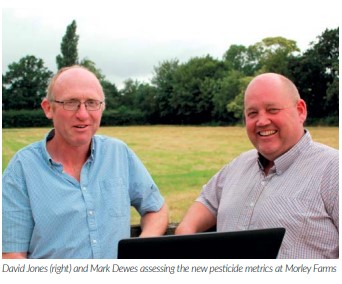
Agronomist In Focus…
EVALUATING THE IMPACT OF PESTICIDE USE ON NATURAL CAPITAL
Natural Capital is being measured in novel ways and carbon accounting is now commonplace. It is difficult to be precise about the measurement of the effects of different management practices on soil carbon, so it seems likely that the adoption of management which we know to be more carbon efficient will be a more important short-term yardstick than the increments of this or that measurement of soil carbon. Among the plethora of carbon counting models, one will probably emerge as the dominant approach and, in time, we will all adopt the same standardised system which evaluates our initial progress through the practices we adopt. In the longer term this will be validated through more tangible measures of success, showing the sequestration which can be achieved in the longer run..

The position with measurement of carbon is likely to be repeated after a lag in time with biodiversity – the other big area of Natural Capital upon which we have such a large potential impact, both positive and negative. Just as it may be more appropriate to measure the adoption of carbon efficient management than actual soil carbon to assess progress toward Net Zero, it seems we need some effective measurement of pesticide impact to assess our progress toward a reduction on negative effects on biodiversity. Well-planned changes in variety, rotation and agrochemical choice offer significant opportunities to minimise the unintended impact of pesticide use to protect the environment in which we live and work and the soils which we curate. Additionally, we will need to demonstrate this careful management to the wider world.
This is the conclusion of studies with a new approach to measurement at Morley Farms in Norfolk (the farming enterprise of The Morley Agricultural Foundation). I have been working on this approach with my old college friend and farm manager, David Jones who does all the farm’s agronomy.
There are no national targets for pesticide impact reduction yet, but the pressure will only grow as pesticide use becomes more of a consideration in our ‘social licence to operate’. For our economic sustainability too, we have to use the products at our disposal in the best-informed and targeted way.
Current metrics used in the Pesticide Use Survey including overall weight and treated hectares are of limited use in assessing comparative impact of different pesticide choices as they take no account of the concentration or rate of use of different products. Any improvement of these measures needs to be sufficiently simple and understandable to all concerned to be of real value. Measures like Pesticide Load Index (PLI) and Environmental Impact Quotient (EIQ) based on multiple and often poorly understood factors in complex equations are available, but their complexity and lack of transparency makes them both inappropriate and impractical. Treatment Frequency Index (TFI) appears be a more useful option and has been an important part of the development of pesticide metrics in countries like Denmark.
Measuring the number of full rate equivalent applications of each product used per hectare, TFI is quick and easy to calculate from existing field records. This makes it simple to incorporate into existing field recording for individual monitoring by crop, farm, regional and national reporting scales. TFI doesn’t take complete account of the relative equivalence of different pesticides but being based on the full recommended label rate for each product – derived from extensive toxicology and other studies under-pining their official authorisation – it is a good proxy for pesticiderelated harm. To develop TFI further, weightings for specific products from the Harmonised Risk Indicator (HRI) system used within the EU to track the impact of pesticide use. This system awards fewer weighting points for the more environmentally benign products in the calculation and could help to interpret the relative potential impact of different active ingredients.
For a practical example of how the system could work we can examine the results from Morley Farms which extends to around 750ha in several holdings, 700ha of which are cropped. Winter wheat and sugar beet are the mainstays of a flexible rotation which has been extended in the past two seasons with substantially more spring cropping and no oilseed rape to improve economic as well as environmental sustainability. David Jones explains: “At Morley Farms our farming is closely interwoven with long-term research and education. We focus on securing the best possible performance from our cropped land, so we need less of it for production, leaving more for the wildlife features and habitats we have been actively creating and managing for more than 25 years now.
“We are passionate about minimising the unintended consequences of the crop protection inputs essential in our cropping through the best-informed Integrated Pest Management (IPM) too. To do this we need a much better way of monitoring pesticide use and impact than we’ve had to date.”
Morley Farms cropping records over the past decade show a wide variation in pesticide use from year to year as David and his team have responded to different rotational and seasonal pressures.
Applying the new metrics to three years of full field records from 2018 to 2020 shows the annual whole farm Treatment Frequency Index varying between 5.3 to 6.4 and averaging 6.0 – indicating an average of six full rate equivalent pesticide applications per hectare. Table 1 shows the calculation for Spring barley in 2020.
Weighting these applications for their relative potential harm here gives an average three-year Harmonised Risk Indicator score of 6.9 (varying from 6.0 to 7.7 depending on the season and cropping Table 2).
Table 1. Treatment Frequency Index (TFI) calculation
Spring Barley 2020

Oilseed rape stands out as a high impact crop on both measures. While a bigger swing than intended to spring planting following seriously disrupted winter wheat drilling undoubtedly played a part, it can be no coincidence that dropping OSR from the Morley rotation in 2020 was accompanied by a reduction of around 20% in both TFI and HRI.
“Although our overall rating will always vary from season to season depending on rotation, crop condition and pest pressures, the rolling average three or five year HRI should provide us with a good indicator of how well we are doing in moderating our pesticide impact.” “Alongside margin, it looks like it could be a really useful routine measure of individual crop and farm performance for us. Especially if we calculate it on a per tonne basis rather than just per hectare to reflect the value of crop protection in supporting higher production. “A per hectare HRI of 10.2 in 2019 and 8.2 in 2020, makes our earlier wheat crop look worse. But factor in the 11t/ha yield average in 2019 against 9.0 t/ha in 2020 and the positions are virtually identical at 0.93/t and 0.91/t respectively (Figure 1).
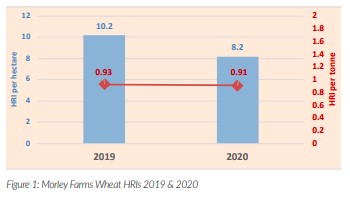
“Knowing the relative pesticide impact of our different crops from past experience also provides us with additional intelligence to take into account in our rotational planning, The HRI data has already underlined the pesticidereducing value of eliminating OSR from our rotation in 2020. Although on only a single season’s figures, it strongly suggests introducing spring oats and forage maize could have particular value here too – in addition to their other benefits.
Table 2: Morley Farms Pesticide Impact Metrics (2018-2020)
TFI – Treatment Frequency Index; HRI – Harmonised Risk Indicator
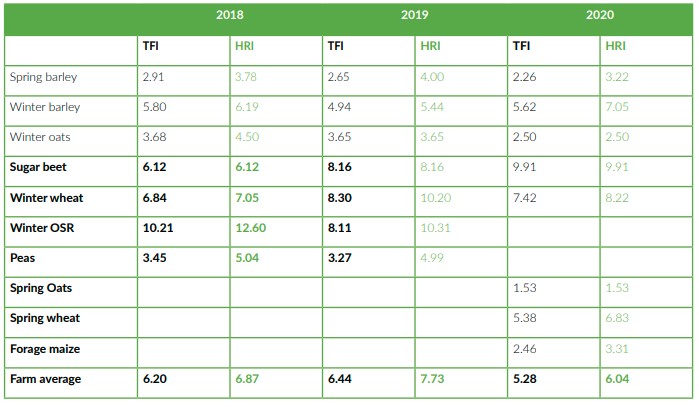
“Having HRI as a standard metric in our crop performance monitoring would give us a really good measure of pesticide impact to take into account in our improvement efforts. It would allow us to set targets for reducing our reliance on pesticides as we plan ahead; develop our cultural controls to help us meet them; and track our progress in achieving them field-by-field, crop-by-crop and season-by-season. “Precise measurement standards need to be agreed by all concerned but could be useful to incorporate into ELMS – as an IPM target perhaps?”
Applying the Harmonised Risk Indicator weightings to the Morley Farms data also provides valuable pointers to practical ways in which pesticide impact can be reduced through changes in individual crop agronomy. Reflecting their effect on non-target species, pyrethroid insecticides used to combat aphids and BYDV attract a higher weighting in the HRI system.

Calculations show that eliminating the single insecticide spray used in winter cereals at Morley in 2020 would have reduced winter cereal HRIs by 15-20% (Figure 2). This underlines the potential value of BYDV tolerant varieties, sowing date adjustments and the use of prediction models.
Regardless of the detail, the most important thing about these metrics is that they provide a simple yet objective and independently defined way of measuring the likely unintended impact from pesticide use which have the potential for stakeholder support and uptake.
Against the background of the growing debate over the future of pesticide use and the limits of any legislation that might govern it, farming needs to take the lead in developing measures like this that are both widely acceptable and usable. It is vital, though, that we don’t wait for the establishment of the means to measure these improvements before implementing the things which we know will work. The concept of additionality (where rewards are targeted only to those who can demonstrate improvements, regardless of the starting point) has the potential to delay the implementation of improvements and should be treated with caution for all Natural Capital accounting. Our impact on biodiversity needs the counting systems to help us balance the books.
-

Farmer Focus – George Sly

And Breathe….. a much better year
After 2019 and 2020, I think we can all agree 2021 has been a much happier time to be farming. Prices are good, yields were ok to good, the autumn has been very kind, autumn establishment cracking, smiles all round in the Sly Family, turkey is on the menu again this Christmas
Agroforestry update:
We harvested the annual alleys in our agroforestry field for the first time this year. We drilled explorer spring barley on 24m alleys in between the hazels and walnuts. We had a pleasing yield and made malting spec with the barley, I must admit we had to be very careful with spraying and we will have to be very vigilant for the first 4-5 years. It’s strange, but having a field with 12 X 24m alleys automatically makes you ‘experiment more’ in terms of trying different things in each alley. We did 3 trials, which I will discuss further later on.
Overall, the agroforestry so far has been very successful, the AB8 strips have established well, the trees have largely survived year 1. We have lost 4 walnut trees (from 240) to hares/ deer and just under 25 Hazelnuts (from 600). Given the March planting date I am happy with that and we have learnt a lot. In terms of time in the field consumed by the trees, we have walked the tree rows twice in an 11 month period and mowed the AB8 twice. Overall on this 16 hectare field, that has consumed 27 man hours. The walking was to check / fix guards, log on a tablet any dead / suffering trees and hand weed anything that’s troubling in the AB8 strips. As of yet we haven’t applied any pesticide to the tree rows.
When we planted the trees, we did apply some muck / mulch and Leonardite as a soil conditioner. We have another 16 hectares to plant December 2021 / January 2022 and then in 2022 / 2023 winter a further 40 hectares. This will bring us close to 2500 trees. We will begin planting some timber as well as nut trees in 2023 as long term projections look very attractive.
I do LOVE having the mix of perennial and annual plants in the same field, everything is yet to be proven, but somehow it just feels right for the future.
-
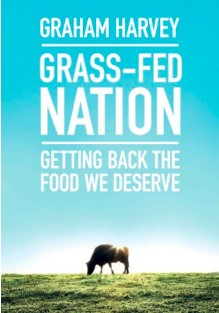
What Do You Read?
If you are like us, then you don’t know where to start when it comes to other reading apart from farming magazines.
However, there is so much information out there that can help us understand our businesses, farm better and
understand the position of non-farmers. We have listed a few more books you might find interesting, challenge the
way you currently think and help you farm better.
Grass-Fed Nation: Getting Back the Food We Deserve
Modern agriculture has locked us into an unhealthy, vicious circle, with degraded foods pouring from an overstretched, impoverished landscape. There’s a simple remedy: the grassfed movement. We can make sure that the meat, dairy foods and eggs we buy come from animals grazing on or running in pasture, as they always used to. This will also put life back into our soils and wildlife back onto our farmland. Graham Harvey, former agricultural advisor to BBC Radio 4’s The Archers, lays out all the arguments for grass-fed food – why it’s good for us, and why it’s good for the planet.
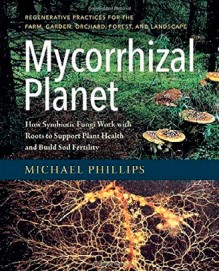
Mycorrhizal Planet: How Symbiotic Fungi Work with Roots to Support Plant Health and Build
Soil FertilityMycorrhizal fungi have been waiting a long time for people to recognize just how important they are to the making of dynamic soils. These microscopic organisms partner with the root systems of approximately 95 percent of the plants on Earth, and they sequester carbon in much more meaningful ways than human “carbon offsets” will ever achieve. Pick up a handful of old-growth forest soil and you are holding 26 miles of threadlike fungal mycelia, if it could be stretched it out in a straight line. Most of these soil fungi are mycorrhizal, supporting plant health in elegant and sophisticated ways. The boost to green immune function in plants and community-wide networking turns out to be the true basis of ecosystem resiliency. A profound intelligence exists in the underground nutrient exchange between fungi and plant roots, which in turn determines the nutrient density of the foods we grow and eat.
Exploring the science of symbiotic fungi in layman’s terms, holistic farmer Michael Phillips (author of The Holistic Orchard and The Apple Grower) sets the stage for practical applications across the landscape. The real impetus behind no-till farming, gardening with mulches, cover cropping, digging with broadforks, shallow cultivation, forestedge orcharding, and everything related to permaculture is to help the plants and fungi to prosper . . . which means we prosper as well.
Building soil structure and fertility that lasts for ages results only once we comprehend the nondisturbance principle. As the author says, “What a grower understands, a grower will do.” Mycorrhizal Planet abounds with insights into “fungal consciousness” and offers practical, regenerative techniques that are pertinent to gardeners, landscapers, orchardists, foresters, and farmers. Michael’s fungal acumen will resonate with everyone who is fascinated with the unseen workings of nature and concerned about maintaining and restoring the health of our soils, our climate, and the quality of life on Earth for generations to come.
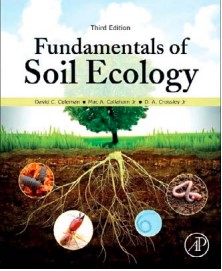
Fundamentals of Soil Ecology
Fundamentals of Soil Ecology, 3rd Edition, offers a holistic approach to soil biology and ecosystem function, providing students and ecosystem researchers with a greater understanding of the central roles that soils play in ecosystem development and function. The text emphasizes the increasing importance of soils as the organizing center for all terrestrial ecosystems and provides an overview of theory and practice in soil ecology, both from an ecosystem and evolutionary biology point of view. This new edition is fully updated, including an expanded treatment of microbial ecology and new sections on advances in molecular techniques and climate change research. These updates make this edition an essential resource for researchers and students in soil ecology and microbiology.
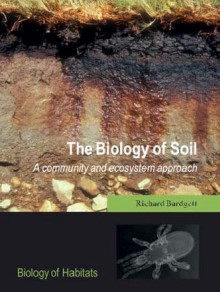
The Biology of Soil: A Community and Ecosystem Approach
(Biology of Habitats)This book is unique in providing a comprehensive, up-to-date synthesis of what is known about soil biodiversity and the factors that regulate its distribution, as well as the functional significance of belowground biodiversity for ecosystem form and function. It describes the vast diversity of biota that live in the soil environment – the most complex habitat on Earth – and discusses the factors that act as determinants of this diversity across different spatial and temporal scales. The Biology of Soil also considers how biotic interactions in soil influence the important soil processes of decomposition and nutrient cycling .
It demonstrates how interactions and feedbacks between diverse plant and soil communities act as important drivers of ecosystem form and function. The importance of these relationships for understanding how ecosystems respond to global change phenomena, including climate change, is discussed in depth. Much is still to be learned about the soil biota and their roles in ecosystems, and the author highlights some of the many challenges that face ecologists in the exploration of soil. Richard Bardgett has wide experience in soil and terrestrial ecology, and his background of research in many ecosystems is reflected in this book which is the most comprehensive, upto-date volume currently available in soil ecology.
It provides an introduction to the biology of soil, and it also discusses the most recent developments in this progressive field of ecology. The importance of soil biotic interactions for community and ecosystem ecology is illustrated through the use of numerous examples and case studies. The Biology of Soil provides an excellent, easy to read introduction for anyone working in the field of soil ecology and related disciplines, and will be ideal for students taking undergraduate and postgraduate courses in soil ecology, plant-soil relationships, ecosystem ecology, and land management.
-
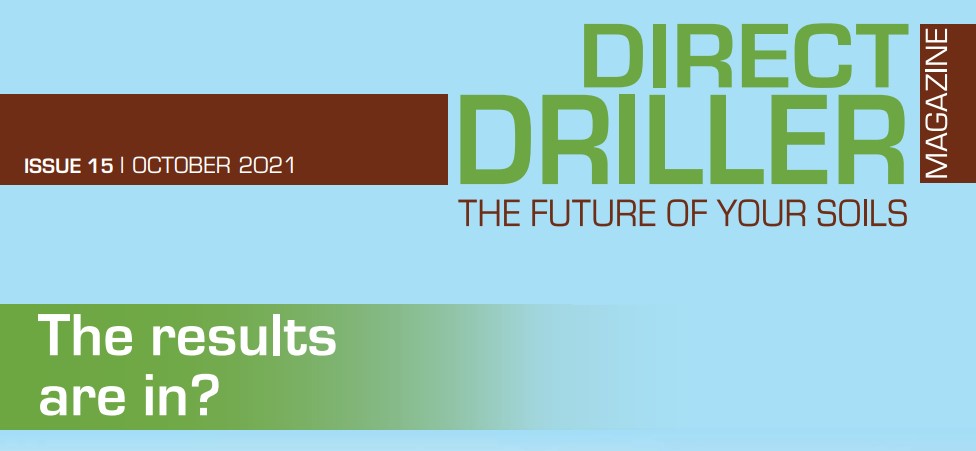
The Real Meaning of Knowledge Transfer
If this issue of Direct Drilling says anything, it is that farmers are not afraid of change. Every one of the farmer focus articles describes how the contributor has made changes to many of the inputs under their control. It provides a vast amount of highly relevant and valuable information for all involved in arable farming, and in particular direct drilling. One gem that came from Clive Bailye is the observation that the drought resistance of cereal rye is far better than winter wheat. (pg 30) Arable farmers need to make time to read these and the other technical articles in their free paper copies (www.directdriller. com) or from the on-line issues.
This is information which is shown to make a real difference in outcome, to both soil health and financial performance. These experiments done by those who are curious as to what happens when things get altered are a huge contrast to the ‘we do it this way’ approach. The dictats of the War Ag conditioned farmers to do what they were told by advisors who came from institutions and, in the last few decades, increasingly from commercial suppliers. There was little appetite to argue and do it different. Brexit, which has coincided with the explosion of communication methods, has opened the door for wider research.
Change in UK farming includes post Brexit farm payments. The end of the greening rules has been welcomed, and these are the first of huge changes to Defra and Rural Payments. The Sustainable Farming Incentive pilot scheme (www.gov.uk/guidance/ sustainable-farming-incentive-pilot), required those interested to provide an ‘expression of interest’ in the window Mon 15 March to Sunday 11 April. Some 2,000 were accepted and have needed to complete their application by the end of Sept to start their pilot scheme in October.
So far there has been muted response, perhaps partly the result of it being bang in the middle of harvest. Pilot participants get £5,000. The scheme will support approaches to farming that deliver for the environment such as soil health, IPM, and hedgerows. It looks as if it is a case of early birds catching worms. The Defra changes will in time involve dispensing a large budget, and knowledge of how it works and the application procedures are the next hurdle for farmers to clear.



-

The 3.5% Rule
The “3.5% rule” refers to the claim that no government or organisation has withstood a challenge of this percentage of their population or membership mobilised against it during a peak event. This rule is based on an insight that political scientist Mark Lichbach developed in his 1995 book “The Rebel’s Dilemma”.
In it, he speculates that no government could withstand a challenge of 5% of the population; and that no rebellion could hope to mobilize more than 5% of the population anyway because of popular incentives to free ride on more risk-acceptant revolutionaries. Given where we are with Red Tractor, I think this logic is worth highlighting to farmers. Who often feel they have no power. This figure for all of UK farming is 8400 farmers. Probably only 2200 if you look at Cereals and Oilseeds. Therefore, if we want change in farming, it can happen. Get 2199 of your colleagues to stand outside the AHDB in Stoneleigh or the Red Tractor offices in London or the NFU offices in Stratford-upon-Avon and make your presence felt.
The big question is, have that many farmers ever agreed on a single subject?
The history of farming has been dominated by the opinions of the few. The NFU, CLA, RT, AHDB decide what farmers think and that becomes policy. The worrying thing is that none of those organisations elect people into positions of power in a very “democratic” way. That includes the way the NFU elect officials, as I was told once “the NFU are wise” in explanation to why a particular person could and would never get elected to the top position. Not exactly the “they will never get the votes” answer I was expecting.
What is clear is that, the few make the decisions on behalf of the many, as with all systems of governance. But this is changing and given the 3.5% rule it can change whenever you want it too. To this point, we now distribute this magazine to over 5000 farmers and it’s read by more than 18,000 with our online and PDF readers.
Thus, this magazine has surpassed that threshold. As has the attendance of Groundswell and have you noticed how much Regenerative Agriculture has become popular outside farming recently and in the media? This is the 3.5% rule in action. We as a group have got together, expressed our opinions and they have been listened to. Change is possible and you have more power than you think.
-

Knowledge Transfer
Despite the pandemic and the likely economic crises in its wake, people continue to experience a growing anxiety concerning greenhouse gases (GHG) and climate change, which extends to include farms and food production. While farming, and the process of photosynthesis, is one of the few ways of reducing CO2, livestock production and soil cultivation release GHGs to a significant extent. If emission targets are to be met, farm emissions will need to be reduced. Getting farmers to emit less involves persuasion as well as financial inducements. KT – knowledge transfer – plays a big part in creating a climate of change.
KT has been around farming for some years and ranges from a informal discussion group to a full blown lecture from a leading professor. But it also includes literature such as the Direct Driller you’re reading today. Publications such as this are, in fact, an excellent way to help modernise an industry, and by this I’m not thinking of a new tractor or 4×4. Modern farms which pollute less, protect nature more, produce a more natural product are businesses that have all made changes, often with considerable scepticism. They have invested, sometimes reluctantly. They have absorbed the jibes of neighbours.
KT can be a huge yawn or a life changing moment. As a dairy farmer I’ll never forget going to a talk in 1982 on New Zealand farming where Everett Thorburn from the NZ dairy board explained the benefits of NZ breeding, and how a NZ bull with a heifer yield of 4,800 litres can be a better buy than a Holstein with 7,000. I was young and rash, ordered NZ semen and, in the course of the next dozen years, changed my herd from average to being really profitable. It took time, patience and belief.
That ninety minute talk prompted an immediate response because it was logical, factual and entirely relevant to a grass farm in West Wales, and decades before the internet, which today brings farmers so much closer together. As you read your way through this issue, finding out how manufacturers have improved the performance of their direct drilling equipment; just how dependent UK farming is on Basic Payment from analysis by Gary Markham of Land Family Business; how GHG intensity varies with crop yields; what the latest research reveals. Add to this the many ‘Farmer Focus’ pages where real farmers explain the hows, whys and results of making a change in their methods.
These real time experiences are inspiring and motivating. If farming is to achieve its goals on climate change it is these farmers who will kick start others to make the change. Abandoning the plough, power harrow and cultivator is not easy, needs commitment and care in deciding the best way to go. Reading how people have achieved success can be very elevating! If you would like to contribute just give me a call 07778 877514. Last but not least, it is worth remembering this publication comes to you at zero cost, thanks to the foresight of its creator Clive Bailye, and the advertisers and supporters who pay the bills.



-

Green Grains
There is so much talk about carbon at the moment, and there is no doubt that farmers will make some income by changing practices to sequester a bit more carbon. Buying HVO versions of Red Diesel is just an example of a way to do this. It costs you are little more to fill the tank, but the costs are outweighed by the carbon you save. But I think carbon is the sideshow.
Carbon could be worth £90 a hectare, maybe a bit more, but imagine if you could get an extra 10% on your sale price for your certified carbon neutral “green” wheat. At today prices that’s over £200 a hectare for many farmers. And looking at the market as it stands right now, 10% is a conservative estimate. Carbon neutral fuel is currently 80% more expensive. Energy saving lightbulbs where 400% more expensive when they first were released. Equally carbon neutral electricity is now offered at the same price in a mature market.
The NFU has told everyone that we will be carbon neutral by 2040. By then, roughly half of farmers need to be sequestering in order to balance out the other half. Therefore, farming will always have the concept of carbon neutral products and those that aren’t. This may well be arable balancing out livestock, but not all arable farms will get there (or want to get there). This creates and maintains a market that does not exist right now.
Speaking to the supermarkets and the fuel companies, this is the thing they are most excited about. More than buying the carbon offsets, being able to buy green in the first place. However, that just leaves the mills in the middle. They have zero interest in this so far, as processing grain whether green or not, makes little difference to them. But it does matter to the end customer and that is who buys the food we produce. The regenerative story is like catnip to housewives who shop in Waitrose and M&S. That means they day isn’t far off when Waitrose say they are only sourcing grains from certified regenerative agriculture farms.
Are you ready though?

